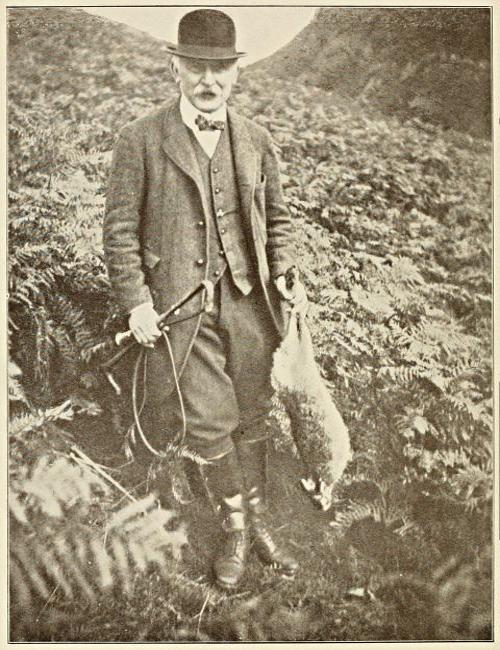
BRUCE LOGAN, ESQ., M.F.H., MASTER OF THE CONISTON FOXHOUNDS AND THE WINDERMERE HARRIERS.
Project Gutenberg's Foxhunting on the Lakeland Fells, by Richard Clapham This eBook is for the use of anyone anywhere in the United States and most other parts of the world at no cost and with almost no restrictions whatsoever. You may copy it, give it away or re-use it under the terms of the Project Gutenberg License included with this eBook or online at www.gutenberg.org. If you are not located in the United States, you'll have to check the laws of the country where you are located before using this ebook. Title: Foxhunting on the Lakeland Fells Author: Richard Clapham Contributor: J. W. Lowther Release Date: April 20, 2018 [EBook #57007] Language: English Character set encoding: UTF-8 *** START OF THIS PROJECT GUTENBERG EBOOK FOXHUNTING ON THE LAKELAND FELLS *** Produced by MFR and the Online Distributed Proofreading Team at http://www.pgdp.net (This file was produced from images generously made available by The Internet Archive)
FOXHUNTING ON THE LAKELAND FELLS

BRUCE LOGAN, ESQ., M.F.H., MASTER OF THE CONISTON FOXHOUNDS AND THE WINDERMERE HARRIERS.
FOXHUNTING ON THE
LAKELAND FELLS
BY
RICHARD CLAPHAM
WITH AN INTRODUCTION BY THE
RIGHT HON. J. W. LOWTHER
Speaker of the House of Commons
WITH 43 ILLUSTRATIONS FROM PHOTOGRAPHS BY THE AUTHOR
LONGMANS, GREEN AND CO.
39 PATERNOSTER ROW, LONDON
FOURTH AVENUE & 30th STREET, NEW YORK,
BOMBAY, CALCUTTA, AND MADRAS
1920
All rights reserved
DEDICATED TO
BRUCE LOGAN, ESQ., M.F.H.
Master of the Coniston Foxhounds
and Windermere Harriers
with both of which packs I have enjoyed
so much good sport during the
last ten seasons in the
fell country
By the Right Hon. J. W. LOWTHER, M.P.
That portion of Cumberland and Westmorland, which is popularly known as the Lake District, is the holiday ground of a great number of persons who delight in its splendid scenery of mountain, wood and lake, who enjoy roaming on foot over its uplands, climbing its peaks, driving in motor or charabanc along its sinuous valleys, rowing or sailing on its lakes, and sketching or photographing its picturesque views, which present themselves to even the most inartistic eye. But these folk belong to the family of “Hirundinidæ”—swallows—they are summer visitants.
To my mind, the Lake Country, always beautiful, is more beautiful at the other three seasons of the year. In the spring and autumn the grasses and mosses of the upper slopes and of the smooth round shoulders, the bracken of the lower slopes, the larch woods creeping up from the valleys, and the emerald green of the lush meadows present finer contrasts of colour and more variety of shade and tone than the monotonous green of summer; whilst in winter the snow-capped mountains look higher and grander and more inaccessible, the[viii] effects of light and shade are more varied, and even on the lower slopes, by reason of the lower altitude of the sun and the prolongation of shadows, the folds and crinkles of the mountain bases are more distinctly seen. Visitors, however, are comparatively few, for days are short and often wet, the attractions fewer in number, and accommodation in the remoter spots not easily available. But those who come, and are fortunate in their meteorological experiences, are amply rewarded; and, if they are able-bodied and active, can enjoy the hunting which some four or five packs of hounds afford.
To most people “hunting” connotes horses and riders, and red coats, and breeches and boots. The Lakeland hunter, however, sees none of these things. At most he will catch an occasional glimpse of the scarlet coat of huntsman or whip. A horse would be as much out of place at a meet of a fell-side pack as a hippopotamus, and be about as useful. Breeches and boots would be an impossible handicap. The iron horse, the bicycle, takes the place of the covert hack, knickerbockers of leathers, and shooting-boots of tops.
The mountain packs of hounds were instituted or taken over by the farmers of the district for the protection of their flocks from the depredation of the numerous foxes, which frequent the fells, and at times take a heavy toll of the lambs in the[ix] spring. But to business has been added pleasure. Business, however, comes first. A day’s hunting is always something of a lottery, whether it be in Leicestershire or in Lakeland, and it may be at once conceded that the Shires produce more prizes than the fells; but, on the other hand, the fells never result in a “blank” day. The climatic conditions, propitious as they are for scent, often militate against complete enjoyment of his surroundings by the follower of the hunt. He must be prepared for a very early rise, a long day in the open air, a steep climb, a dreary trudge up or down interminable slopes of grass or moss, a scramble across shifting screes, long waits, biting blasts, heavy showers, drenched garments, the descent of mist, or the loss to sight and hearing of the pack and all its followers. All these calamities, however, do not often occur in combination. Let us look at the brighter side of things. Then the sportsman may enjoy a glorious outing, a steady climb, when every 100 feet of ascent seems to strike a purer stratum of invigorating air, a gradually expanding view of distant mountain tops, a glimpse of the Solway or the Irish Channel miles away, and when the summit is reached a magnificent panorama of peaks and precipices, of vast stretches of smooth uplands and diminutive lakes. Then comes the satisfying sense of “something attempted, something done.” There is also always the chance[x] of having selected a spot from which a good view of the hunt may be obtained, when the fox can be seen crossing the breast of the opposite hill with the hounds stringing out far behind, the anxiety whether he means to come this way or cross the opposite skyline. If all turns out luckily the music of the pack grows gradually fortissimo, the fox slips quietly past, but is rolled over in full view.
It is not my intention to attempt a record of the doings of any of the fell packs, of one of which (the Blencathra) I had the honour of being for several years the Master. I need now only express my great regret that parliamentary duties in London coincided unfortunately with the foxhunting season in the Lakes, and limited very severely my opportunities for the enjoyment of the sport, which I commend to all who are still sufficiently young in spirit or vigorous in body to enjoy this healthy pastime. Young and old alike will find in Mr. Clapham’s pages an invigorating description of the sport, as well as a record of minute and extensive observation of the habits and idiosyncrasies of the four-legged participants in the pursuit and a keen appreciation of the beauty of the surroundings in which Lakeland hunting is carried on.
Whilst there are a good many books descriptive of foxhunting in the Shires and the provinces, there are few works entirely devoted to sport in the rough fell country of the Lake District.
It is, therefore, with the idea of filling this gap in hunting literature that I venture to pen the following chapters. Foxhunting on the fells differs in so many ways from sport in the riding countries that perhaps this book may serve to interest the man from the Shires, even if it does not tempt him to visit the fells and see something of the sport for himself.
For the man of slender purse the fells will prove a happy hunting ground indeed. There is little cause to worry about ways and means in a country where subscriptions vary from 2s. 6d. to £5. All you want to enable you to follow hounds is a stout heart, a stick, and a “piece” in your pocket, and if luck favours you, as it assuredly will if you go out often enough, you will find yourself[xii] becoming more and more wedded to this wild country, which, in sunshine or storm, has so many attractions for those who are not afraid to tackle it in all its varying moods.
R. CLAPHAM.
Troutbeck,
Windermere,
April, 1920.
| CHAPTER | PAGE | |
| I. | The Country | 1 |
| II. | The Fell Fox | 23 |
| III. | The Fell Hounds | 47 |
| IV. | Hunting on the Fells | 70 |
| V. | Reminiscences | 99 |
Page 24, line 16: for twenty-one read twenty-three.
Page 110, line 2 from bottom: for sixty read thirty.
| FACING PAGE | |
| Bruce Logan, Esq., M.F.H., Master of the Coniston Foxhounds and the Windermere Harriers | Frontispiece |
| Fell Hunting Country: The High Street Range, from Troutbeck Park | 4 |
| Fell Hunting Country: The High Street Range, from Wansfell | 4 |
| Coniston Foxhounds: Hounds and their Huntsman climbing Steel Fell, in the Snow | 10 |
| Coniston Foxhounds: A Kill in the Snow on Steel Fell, near Grasmere | 12 |
| Charles Wilson, Esq., Ex-Master and Huntsman of the Oxenholme Staghounds | 14 |
| (Mr. Wilson formed this pack in 1887, and was Master and huntsman for over thirty seasons) | |
| Coniston Foxhounds: After a Kill in the Low Country | 18 |
| (An admiring audience of boys looking at the fox) | |
| Coniston Foxhounds: Bruce Logan, Esq., M.F.H., and Robert Logan, Esq., Deputy Master | 20 |
| Broad Howe: A “Borran” or Earth at the Head of the Troutbeck (Windermere) Valley | 28 |
| (This is a very strong place, and is typical of the fell-country fox-earths) | |
| Looking into Broad Howe “Borran” from above, after Men had worked for a Week to rescue Two Terriers, One of which died below Ground | 28 |
| The Armistice | 38 |
| A Three-Weeks-Old Fox Cub | 40 |
| Fox Cubs, Three Weeks Old | 40 |
| A Dog-Fox Cub, Ten Days Old | 42 |
| (Note white tag to immature brush) | |
| Miss Hilda Chapman (Daughter of Anthony Chapman, Ex-Huntsman of the Windermere Harriers) and her Pet Fox, “Jacky” (Three Years Old) | 42 |
| “Cracker,” late of the Coniston Pack: A Big Hound of the Fell Type | 50 |
| “Mischief,” late of the Coniston Pack: A Bitch of the Fell Type | 50 |
| Coniston Foxhounds: The Pack | 54 |
| Coniston Foxhounds: The Pack in Kennels at Greenbank, Ambleside | 54 |
| Ullswater Foxhounds: The Pack with their Huntsman. Opening Meet, Oct. 11th, 1919 | 58 |
| [xvi]Coniston Foxhounds: At the “Travellers’ Rest” Inn, on the Summit of the Kirkstone Pass (1469 ft.) | 64 |
| Coniston Foxhounds: Waiting for the Pack on the Fell | 64 |
| Blencathra Foxhounds: on Right, George Tickell, Esq., Ex-Deputy Master (1907-1919) | 70 |
| (Mr. Tickell has hunted regularly since he was a boy at school, thus covering a total of nearly seventy years. He is “still going strong”) | |
| Fell Country Huntsmen: Left—George Chapman, Huntsman, Coniston Foxhounds. Right—Jim Dalton, Huntsman, Blencathra Foxhounds | 74 |
| Ullswater Foxhounds: Joe Bowman, the Huntsman | 76 |
| Blencathra Foxhounds: Gone to Ground on Armboth Fell | 77 |
| Blencathra Foxhounds: After a Kill at Raven Crag, near Thirlmere Lake, Nov. 7th, 1919 | 77 |
| Ullswater Foxhounds: Opening Meet at Brotherswater, Oct. 11th, 1919 | 80 |
| (Joe Bowman, the huntsman, talking to two of the field) | |
| Ullswater Foxhounds: Joe Bowman, Huntsman (since 1879), watching Hounds at Work in Low Wood, near Brotherswater. Opening Meet, Oct. 11th, 1919 | 84 |
| Coniston Foxhounds: “Gone to Ground” | 86 |
| (Hunters working their way into a “borran”) | |
| Ullswater Foxhounds: B. Wilson, the Whipper-in, with Fox killed in Scandale Valley, Oct. 11th, 1919 | 87 |
| “Pincher” and “Myrtle,” Two Coniston Hunt Terriers | 90 |
| “Jummy,” a Terrier which did much Good Work for the Coniston Hunt | 90 |
| Ullswater Foxhounds: Gone to Ground below High Pike in the Scandale Valley, Windermere Lake in Distance | 92 |
| Coniston Foxhounds: Watching a Hunt from Broad Howe “Borran,” at the Head of the Troutbeck (Windermere) Valley | 96 |
| Coniston Foxhounds: Rough Going near Dove Crag | 102 |
| Coniston Foxhounds: George Chapman, the Huntsman, with Fox, after a Kill in Greenburn | 104 |
| Blencathra Foxhounds: Ernest Parker, the Whipper-in, after a Kill at Raven Crag, near Thirlmere Lake, Nov. 7th, 1919 | 105 |
| Ullswater Foxhounds: Opening Meet, Oct. 11th, 1919. Left—W. H. Marshall, Esq., M.F.H. Right—B. Wilson, the Whipper-in | 107 |
| (Waiting for a fox to bolt from an earth below High Pike in the Scandale Valley) | |
| Coniston Foxhounds: Hounds and their Huntsman in the Scandale Valley | 110 |
| Coniston Foxhounds: After a Kill near Coniston | 110 |
| Coniston Foxhounds: After a Kill in Woundale | 111 |
| Coniston Foxhounds: After a Kill on Nab Scar, Rydal | 111 |
Of the many visitors who roam the mountains of the Lake District during the summer months, comparatively few are aware of the fact that the said mountains are the favourite haunt of foxes, or that the latter are regularly hunted during the autumn, winter, and early spring. A panoramic view of the fell country of Cumberland and Westmorland seems hardly compatible with the generally accepted idea of a hunting country, yet for all that this rugged district affords grand sport with hounds. I have more than once when speaking[2] of fell foxhunting been asked the question, “How do you manage to get about and keep in touch with hounds on those awful hills?” The answer is simple, “On foot.” Except in some portions of the low ground, riding to hounds is impossible, so the man who would see something of the work of the mountain hounds must be prepared to face the hills on Shanks’s pony.
Rising from the dales at an angle of from 45 to 70 degrees, or even steeper, the fells tower skyward to a height of 2000 feet and over. On the lower slopes large intakes, rock-strewn and often studded with scattered thorn trees, divide the dales from the fells proper. Above these intakes the ground rises abruptly, and one reaches a country of rocks and crags, deep ghylls and watercourses, with scree-beds strewn broadcast beneath the taller cliffs. The latter are seamed and intersected with ledges, known in local parlance as “Benks,” on which is often found a luxurious growth of heather or bleaberry scrub. It is on these snug well-sheltered ledges that the hill fox loves to make his kennel. Protected from the wind, with a wide view of all the ground below him, Reynard curls up where the sun strikes his couch, and sleeps away the daylight hours.
Here and there on the lower slopes are larch plantations, and straggling coverts of oak and hazel. In these woods foxes lie up, though the[3] fell fox proper prefers to have his kennel at a higher altitude, where chances of disturbance are less. Lower still, where the huge intakes merge into smaller enclosures, the number and size of the woods increase. It is down in this low country that a mounted man can see something of the sport, for though the nature of the ground and the fences prohibits riding right up to hounds, there are plenty of side roads, bridle-tracks and the like, by means of which it is possible to keep in fairly close touch with the flying pack.
Much of this low ground is heather land, and everywhere the bracken flourishes in wild profusion. In summer it is waist-high, and even taller, and in early autumn when it changes from green to russet-brown and yellow, it hampers the footsteps of the man on foot, and, owing to its dryness, makes scenting conditions very difficult. For this reason hounds seldom visit the low ground until a fall of snow or heavy rain has somewhat flattened the bracken beds.
On the lower slopes of the high fells the bracken is equally luxuriant, covering acres of land which would otherwise be good pasturage for the little Herdwick sheep. Foxes, particularly cubs, are to be found in these bracken patches, where they lie and creep about unseen on the approach of an intruder.
On the summits of the high tops the ground is[4] generally fairly level, covered with a short, thick turf.
On some of the mountains, such as the High Street and Harter Fell, there is a very considerable area of this fairly level ground. Such high-fell tracts are known in local parlance as “good running ground,” for across them on a decent scenting day hounds can press their fox severely.
It will easily be understood that the approach to these high tops is impracticable for horses, and even if one reached them on horseback the return journey would be fraught with even greater difficulty and danger. On foot it is a different matter altogether. Every one of the fells can be climbed by some fairly easy route, and, once on the tops, the going is good. No matter at what time of year one rambles on the fells alone, it should always be remembered that there is a certain amount of danger, however small. Without in the least wishing to “put the wind up” the reader, I may say that accidents are liable to happen, and a sprained ankle is quite sufficient to place a man in a very awkward position, particularly in winter, when the days are short and the weather far from good. Still, one can travel the fells for years without meeting with the semblance of such a contretemps, if reasonable care is taken when crossing rough ground.
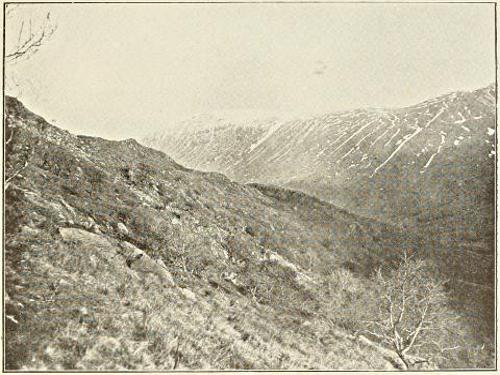
FELL HUNTING COUNTRY: THE HIGH STREET RANGE, FROM TROUTBECK PARK.
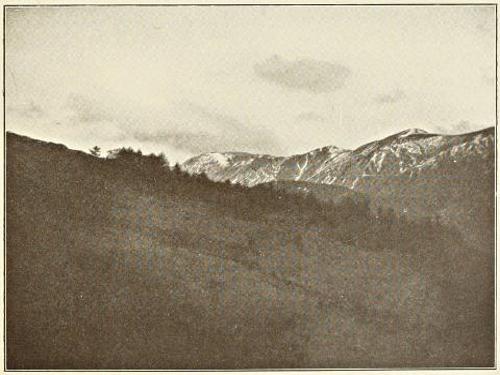
FELL HUNTING COUNTRY: THE HIGH STREET RANGE, FROM WANSFELL.
When hounds are out there are always local[5] hunters scattered about the various tops, and if the visiting sportsman follows the lead of one of these men, he will come to no harm, though he may come to respect the walking powers of a dalesman ere the end of the day.
Having once reached the tops, it is wise to stay at that altitude, unless hounds are practically viewing their fox, and driving him hard towards the dale. It is much quicker to go round the tops than to make a descent to the dale and then climb out again. When necessary, a descent can be made down some grass slope, and a long slide down a loose scree-bed will sometimes gain the same end with less exertion. A certain amount of practice is necessary to enable one to travel the fells with ease, but one soon gets the hang of walking fast on steep ground, and descending the latter at speed.
Everything depends, of course, on one’s physical condition, and the character of one’s footgear. Unless heart and lungs are sound, and one is in some kind of training, fell climbing is astonishingly hard work, and becomes much more of a toil than a pleasure.
Thin boots or shoes, with smooth soles, are useless as well as dangerous. What is required is a good stout shooting boot, well nailed to prevent slipping. If anklets are worn with these they will prevent grit and small stones from entering the[6] boot tops. Shoes are not to be recommended, as they give no support to the ankles. The clothing should be fairly thick and wet-resisting, as the weather on the high tops in winter is often pretty wild. Loose knickerbockers are better than knicker-breeches, as the latter restrain the free action of the knees, and, therefore, make climbing harder. A stick of some kind is a great help, but I do not recommend the long, alpenstock affairs which are sold to summer visitors. On steep ground there always comes a time when a long stick trips its user, and a stumble of this nature may easily lead to a very nasty fall. An ordinary stout walking-stick is the best, as there is little or no chance of getting one’s feet mixed up with it going downhill.
On the high fells the exigencies of the weather have far more influence on sport than they have in the low country. At an altitude of 2000 feet snow is apt to be deep, while the frost is often extremely severe. Snowstorms, unless unusually heavy, seldom stop hunting, but when the snow becomes frozen, and the crags are a mass of ice, it is unsafe for either hounds or followers. The greatest bugbear of the fell foxhunter is mist. Once the tops are shrouded in an impenetrable grey pall there is nothing but the cry of hounds to direct you, and when the music gradually fades into the distance you stand in a silent world of[7] your own, not knowing, if you are a stranger to the fell, which way to turn.
However well you think you know every foot of the ground, it is surprisingly easy to lose direction, and unless a lucky chance places you in touch with hounds again it is wise to get below the mist and discover your whereabouts. As a rule, however, if you are on ground you have often visited before, you will recognise landmarks such as peat hags, cairns, watercourses, etc., which will give you the lie of the land and enable you to go ahead.
Occasionally the fells are what is locally known as “top clear.” At such a time you climb steadily upwards to find yourself at last clear of the clinging grey vapour, and beneath you lies an apparently endless sea of white, stretching into the far distance. Out of this ocean of mist rises peak after peak of the mountain ranges, looking like islands dotted in every direction. If the sun is shining at the time, the glorious panorama will well repay you for your strenuous climb.
Most people have heard of the “Spectre of the Brocken”; well, I have seen exactly the same thing from the summit of Red Screes, which overlooks the top of the Kirkstone Pass.
I was standing on the summit of this mountain one winter’s morning, whilst hounds were working out the drag of their fox on the breast far below.[8] The mist was rising from the lower slopes like a grey curtain, while the sun shone against my back, throwing my shadow on to the screen of vapour. There it became enlarged to enormous proportions, and as I moved the huge shadowy giant aped my actions, until I began to think I was “seeing things.”
I have at times seen some extraordinarily fine rainbow effects amongst the crags, just as the rain began to cease and the sun broke through the clouds.
Next to mist, rain and wind, particularly the latter, handicap followers of the fell hounds. Rain wets you through, but you don’t mind that; it is all in the day’s work, but when it is combined with a driving wind which stops your breath and all but lifts you off your feet it becomes rather too much of a good thing. Once on Wetherlam I saw two coupled terriers lifted bodily off the ground by the wind, and the huntsman’s cap suddenly left his head and departed swiftly into thin air. If it be freezing at such times your clothing, eyelashes, etc., become coated with hoarfrost, and the icy blast penetrates to your very marrow. In the face of such a wind you have to constantly turn round to get your breath, and all sounds beyond the shriek of the gale are obliterated.
Shelter where and how you will, and strain your ears to the uttermost, it is impossible to hear[9] the cry of hounds unless they happen to be very near you. Even on a still day sound is very deceiving. All the hills throw back an echo, and you can easily imagine hounds to be on the far side of a dale, when in reality they are on your own side, but under and beneath you. On one occasion hounds were racing with a glorious cry, apparently near the summit of a mountain which separated us from the dale beyond. Every moment we expected to see them appear over the wall on the skyline, whereas in reality they were on the opposite side of the valley beyond, running through the breast at a high altitude.
Most of the fell country carries a good scent, except sometimes in early autumn and spring, when the sun dries up the dew quite early in the morning. Directly the bracken is beaten down by snow and rain, and the land holds moisture, hounds can work out a drag, and hunt and run with the best.
Although I have descanted upon the bad weather in the fell country, it must not be thought that the winter months are wholly given over to mist, rain, frost and wind. No, there are days when the sun shines brightly on a white world, and the views from the tops are magnificent. The snow is damp but not too deep, and hounds drive along as if tied to their fox. The air is still and clear, enabling one to hear the music at a great distance, and, with good visibility, hounds can[10] easily be seen threading their way through the rough ground across the wide dale. Scent is often very good indeed in damp snow, though at times it may be just the reverse. “There’s nowt sae queer as scent,” unless perhaps it be a woman.
Apart from hunting, I often think that visitors make a mistake in not coming to the fells in winter. Grand as the views are in summer, they are equally fine, if not finer, in winter, when the weather is frosty and settled.
I have already spoken of the impracticability of the fells as a riding country, for if—
the same horseman would find no chance about it on places like Striding Edge or St. Sunday Crag in Lakeland.
At any time of the year many of the huge crags on the fells are dangerous for hounds, and equally so for the too venturesome follower. To mention but a few, there is the crag overhanging Goat’s Water on Coniston Old Man, Pavey Ark in Langdale, Dove Crag at the head of Dovedale, Raven Crag on Holme Fell, and Greenhow End overlooking Deepdale. Most, if not all, of the places mentioned have been the scenes of accidents to hounds, as well as thrilling rescues.
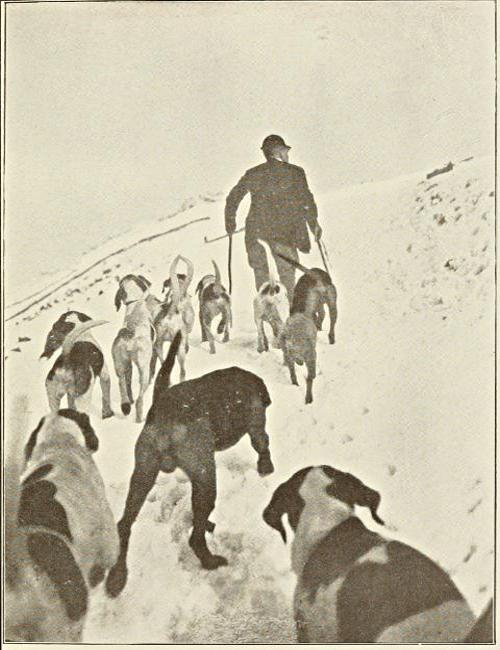
CONISTON FOXHOUNDS: HOUNDS AND THEIR HUNTSMAN CLIMBING STEEL FELL, IN THE SNOW.
Considering the roughness of the fell hunting country as a whole, it is a matter for surprise that[11] there are not more accidents. Although hardly a season passes without a contretemps of some kind, losses amongst hounds of the fell packs through fatal accidents are comparatively rare.
I have previously mentioned the fact that when travelling the fells unaccompanied by a companion, a sprained ankle may give one a pretty bad time, and if night is drawing on may lead to having to pass a night on the open fell. As an example, I may perhaps quote a case which happened not many seasons ago.
I was standing with a huntsman one winter’s day on Wetherlam. There was sufficient snow to cover the loose stones and rocks, and make the latter slippery. The pack was running their fox below us when we espied Reynard coming in our direction. Uncoupling four hounds he had with him the huntsman ran in to give these hounds a view, when I saw him stumble and fall. On reaching him I found he had sprained his ankle very badly indeed, and in a short time his foot swelled tremendously. With my assistance he was able to travel some distance downhill, where I finally left him and went in search of further help. Luckily this was forthcoming in the shape of some hunters whom I overtook, and aided by them the wounded man was able to reach a road, where a trap met him and conveyed him to his home. It was some weeks before he could again hunt hounds,[12] and had he been alone when the accident happened he might easily have had a very bad time of it indeed, as the weather was bitterly cold and the district was an unfrequented one.
We read of people in the Arctic regions going snow-blind, as well as perishing with cold, but the same things may happen on the fells, if one does not take reasonable care.
I was once on the top of Fairfield, at the head of the Rydal valley, when the sun was shining warmly, and the reflected light from the crusted snow was intense. Having previously experienced the symptoms of snow-blindness in Canada, I repeated the experience that day, and I verily believe I should have gone temporarily blind had I not moved away to where the glare was less acute.
As regards perishing from cold, this may easily happen to a person on the high tops in winter, should he, through over-exertion, be compelled, or perhaps I should say, give in to his desire to sit down. A drowsiness comes over one, and sleep may end in the person being badly frozen, if nothing worse. I have recollections of a youth who ventured to the top of Red Screes one winter’s morning on hunting bent, and, being quite unused to hill climbing, sat down in an exhausted condition. He took some rousing too, and had he been left to his own devices I very much doubt if he would have left the hill alive.
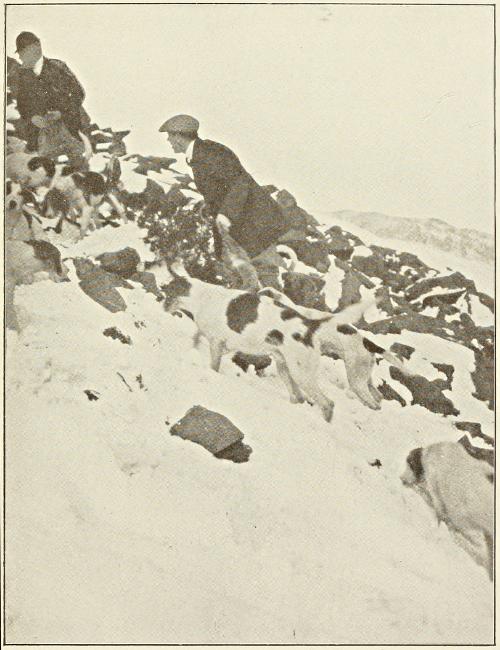
CONISTON FOXHOUNDS: A KILL IN THE SNOW ON STEEL FELL, NEAR GRASMERE.
Although all such happenings are possible, the use of a little care and common sense will carry one through a score of seasons in the fell country without the slightest mishap. One should always remember that the climatic conditions in winter and early spring are very different on the high tops from what they are in the country far below in the dales.
I have come down off the top of Fairfield in April, after being white from head to foot with hoarfrost, into a warm summer atmosphere near Windermere Lake. People generally look at you in surprise if you tell them that 2000 feet above the dales the tops are still well within the grip of winter.
One possible danger that I have so far omitted to mention, is the chance of being overtaken by darkness on the fell. No matter how well you know your way down, on a dark night, it is a thankless job striking matches or peering about with a flashlamp in the rough ground. With a moon and a clear sky you are safe enough, while there is a novelty about walking the tops under such conditions. A night spent on the open fell is bound to be a chilly one, for at a high altitude there is little or no material to make a fire. Still, if you should be caught in the dark, it is better to wait for daylight than risk breaking a leg or your neck over some crag. I have had one or two[14] experiences of struggling down to civilisation in the dark, and I much prefer to do it when there is at least some little light to guide me on the proper route.
I remember once crossing the top of Red Screes by moonlight, after hounds had run their fox to ground at Dod Bields earth in Caiston. It was a brilliant night, however, and we had not the least difficulty in reaching the “Traveller’s Rest” inn, at the head of the Kirkstone Pass.
In the foregoing I have perhaps laid rather too great stress upon the bad weather in the fell country, therefore, I will hasten to add that the winter climate of the Lakeland dales is exceptionally mild. Two thousand feet or more, of course, makes a lot of difference in climatic conditions, and those who do not care to face the exigencies of the high tops can still see much sport with hounds if they stick to the lower reaches of the fells.
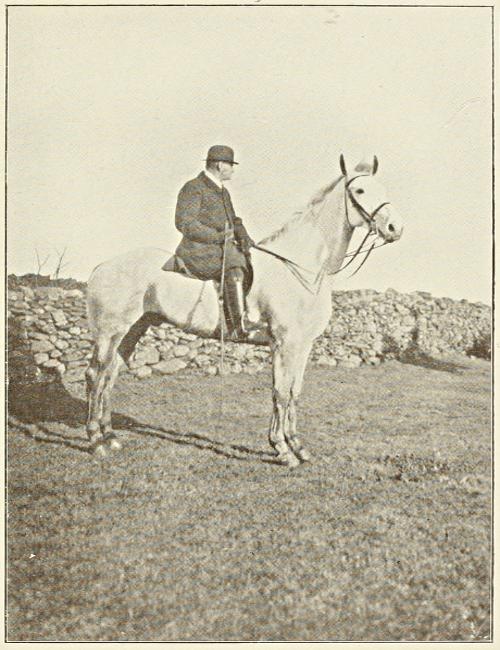
CHARLES WILSON, ESQ., EX-MASTER AND HUNTSMAN OF THE OXENHOLME STAGHOUNDS.
Sometimes the people in the bottom see a great deal more than those on top, and, of course, from below one gets a panoramic view of a hunt, with the entire fell side as the scene of operations. A car, a motor cycle, or even the humble “push-bike” are extremely useful at times during the course of a run with the fell hounds. Occasionally, as, for instance, in the Thirlmere valley, hounds run for a considerable distance parallel with the main road. At such times a car or a cycle enables you to slip[15] along in touch with hounds, whereas without it you would be left toiling in the rear. After some little experience of sport in this wild country, one soon learns how best to get about, and when to trust to “Shanks’s pony,” and where to leave a cycle in case it may be needed in a hurry.
A fair number of ladies attend the meets of the fell packs during the course of a season, and wonderfully well, indeed, do some of them get about.
When speaking of the Lake District, one naturally thinks of Cumberland and Westmorland; but Lancashire contains some of the higher fells, such as Wetherlam and Coniston Old Man. The real boundary of the district is the range of fells south-east of Windermere, and from there a line drawn round Coniston, Wastwater, Ennerdale, Crummock and Bassenthwaite Lakes; continuing over the summits of Skiddaw and Saddleback, southward over Helvellyn, then swinging left to enclose Ullswater and Haweswater, and so back to Windermere. The valleys of Kentmere, Long Sleddale and Swindale are just outside the cordon as drawn above, and so is the Lower Duddon valley on the south-west, but they and all the country included in the roughly-drawn circle, contain scenery typical of Lakeland.
The rainfall in the Lake District appears large on paper, from about 50 inches in the outlying[16] parts to 150 in the more central portions. This, however, does not mean that there is a more or less constant drizzle. When it rains amongst the fells, it rains; a heavy downpour, then clear weather to follow. In summer, as in the hot weather of 1919, there is often a drought.
Speaking of rain reminds me of the yarn concerning the coach-driver, who, when asked by a passenger if they had much rain in the district, replied, “Why, neay; it donks an’ dozzles and does, an’ ’appen comes a bit o’ a snifter, but nivver what you’d ca’ a gey gert pell!”
When out with hounds the visitor will come across many of the small Herdwick sheep scattered about the fells. Before he leaves the district he will no doubt have come to appreciate them as mutton, than which there is none better in the country.
It was Jack Sheldon, another well-known coach-driver, who used to describe the scenery to his passengers, when tooling his team between Windermere and Keswick. His conversation was something like this: “We are now crossing Matterdale Moor, where the farmers have a right of grazing so many sheep by paying a shilling a year to the lord of the manor. There’s fine grass here and on Helvellyn for the hogs!” A retired butcher being on the coach one day remarked, “But I don’t see any hogs!” “Well,” said Jack, “not pigs, but[17] the small sheep you see moving about; they are a special breed, and very good eating. They are called ‘hogs’ for the first year, and when they have been shorn they are called ‘twinters,’ and after losing their second fleece are known as ‘thrunters,’ and that’s pretty near to ‘grunters,’ but when they’re killed the butcher calls them ‘Helvellyn mutton.’”
The Lake District proper is free of limestone, with the exception of a narrow strip of what is known as Coniston limestone. As far as hunting is concerned, this is no loss, for scenting conditions on bare limestone rock are generally bad, unless the atmosphere is very damp. On the north, Penrith is the boundary of the limestone, and in the south, Whitbarrow and Cartmel.
All of the fell country Hunts have some low ground adjoining the fells, which they visit once or twice during the season. This low ground will appeal to those who find fell climbing too strenuous.
The Coniston hounds, which hunt the Windermere district, visit the Winster valley, making their headquarters for the inside of a week at Strawberry Bank. This low country is rideable, inasmuch as it is possible to keep in touch with hounds by making use of side-roads, bridle-tracks, etc. The country consists chiefly of woodlands, with large heather-covered allotments, merging[18] into grass fields in the valley. There are plenty of foxes, but sport is never quite at its best until rain or snow has beaten down the luxuriant growth of bracken, which flourishes everywhere. Here a mounted man has the advantage over one on foot, as when hounds run fast it is difficult to keep in touch with them, and, owing to the woods, quite impossible to see for any distance. I have enjoyed some very good sport there at different times, though I much prefer hunting on the open fells.
Many of the dalesmen are extraordinarily keen on hunting, nor does age appear to daunt them. I know several men over seventy years old who follow hounds at every opportunity. One keen hunter lived to be over ninety, and actually climbed to the top of Coniston Old Man on his ninetieth birthday. It was the immortal Jorrocks’s huntsman, James Pigg, who said, “Brandy and baccy ’ll gar a man live for iver!” but in the case of the north-country dalesman I think it is fresh mountain air and lots of exercise that “keeps the tambourine a rowlin’!”
The various inns throughout the country have harboured many a gathering of hunters after the death of a fox in their vicinity. It is the custom in Lakeland to take the carcass of the fox to the nearest inn, where it is hung from a “crook” in the ceiling of the bar-parlour, for all to see.
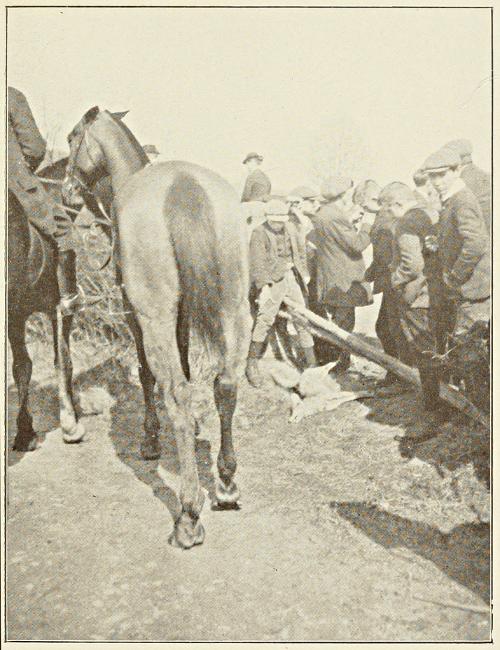
CONISTON FOXHOUNDS: AFTER A KILL IN THE LOW COUNTRY.
Fell hunting engenders a considerable thirst, therefore jugs of beer are in great demand. A pint or two usually incites some hunter to song, and soon the house will be echoing to the chorus of “John Peel,” “Joe Bowman,” or some other local hunting ditty. Gradually the gathering breaks up, the hunters wending their way towards their respective homes, and occasionally, en route, some of them will see more than one fox.
Talking of beer reminds me of the sign which used to grace the famous “Mortal Man Hotel” in Troutbeck; and read as follows:—
The “Traveller’s Rest,” at the top of the Kirkstone Pass (1476 feet), has in its time been the scene of many a foxhunting “harvel” or celebration. An old entry in the visitors’ book ran thus—
[1] The Rev. ⸺ Sewell, formerly Vicar of Troutbeck.
Whilst the fox is our premier beast of chase in Lakeland, the hare is also hunted, and deer provide sport in the country adjoining the fells. In the old days, however, there were two other animals, now very rare, i.e. the polecat and the pine-marten, which were a recognised quarry for hounds.
To-day, as far as I can gather, the polecat, or foumart, is extinct in Lakeland. The pine-marten, or “sweet mart,” to distinguish it from its evil-smelling relation, the foumart or “foul mart,” still lingers on some of the wilder fells.
The pine-marten is a tree dweller by nature, but on the fells it has its haunt amongst the crags and rocks. Hounds delight in the scent of a “mart,” and in bygone days some very good runs took place. The pine-marten, unlike the fox, is very easy to bolt from an earth, owing to its intense dislike of smoke. Directly the first whiff of burning grass or bracken reaches it, it at once takes to the open. The last pine-marten I have seen in the flesh, was a young marten kitten which I was instrumental in securing in 1915. It became the property of a well-known lady naturalist, who reared it successfully, and it proved a charming pet.
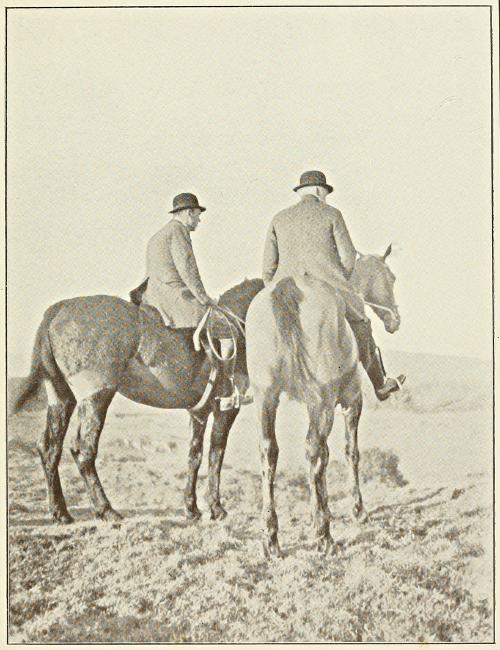
CONISTON FOXHOUNDS: BRUCE LOGAN, ESQ., M.F.H., AND ROBERT LOGAN, ESQ., DEPUTY MASTER.
Although, as far as I am aware, extinct in Lakeland, the polecat is still fairly plentiful in[21] parts of Wales. A year or two ago I had a very fine specimen sent to me from there.
In Vyner’s “Notitia Venatica” is an illustration of foxhounds finding a “marten cat.” One of the hunters is shown up a tree holding some burning straw or other material on the end of a long stick. The pine-marten is represented jumping out of the tree into one adjoining. This marten’s brush is apparently tipped with white, surely a mistake on the part of the artist who drew the picture, as I have never seen or heard of a “mart” with such a white tag to its caudal appendage.
It is a great pity there are not more martens in the country. In addition to being beautiful and interesting creatures, they are the deadly foe of squirrels, which do much harm to trees in young plantations.
The hunting man who is interested in photography will find endless opportunities when out with the fell packs of recording incidents of the chase. It is needless to say that a small light-weight camera should be selected, anything larger than quarter-plate being too much of a handicap on steep ground.
To a lover of sport in wild country, foxhunting in the Lake District must make a strong appeal. In fine or stormy weather the fells have a peculiar charm of their own, and if we add to the beauties[22] of Nature the mellow notes of the horn and the cry of hounds echoing amongst the crags, we can say in the words of the old Roman author—
In John Peel’s time the fell country fox was a distinct variety. Long in the leg, with a grizzle-grey jacket covering a wiry frame, the appellation “greyhound” fitted him exactly. As such he was then known, and the extraordinary long runs which he often provided fully upheld his reputation as a traveller. In habits, too, he was different from the present-day representatives of the vulpine race. Wild and shy, he avoided the haunts of men, and was seldom found lying up anywhere near human habitations. He and his kind were few in number, compared with the ample stock to-day, and in consequence each individual fox travelled a wider beat, and knew more country. It, therefore, naturally followed that hounds often ran fast and far when piloted by one of these old-fashioned “greyhound” customers.
By degrees, owing to the importation of foxes for restocking certain districts adjoining the fells, the true hill fox became infused with this new blood. The new-comers were a smaller and redder variety, and although to-day hounds often account for foxes with greyish jackets, the supply as a whole differs little in appearance from the foxes which are brought to hand in the shires. It may be safely said that the real old “greyhound” variety is a thing of the past, only to be seen to-day staring woodenly from a glass case in the fell-side farmhouses.
Long and lean, the fell fox proper was a much heavier animal than his relations who have usurped his place. Eighteen pounds was a common weight, and instances of twenty and twenty-three pounds have been recorded, but to-day there are more foxes under than over sixteen pounds. Now and then the fell packs kill an extra heavy fox, and I can vouch for the weights of at least three foxes which pulled down the scales to the eighteen-pound mark.
Curiously enough two of these foxes were killed by the Coniston Hounds on the same day. The date was March 16th, 1913, and the first fox was killed at High Dale Park, near Coniston, after a good hunt of two and a half hours. Fox number two was run into on the shore of Coniston Lake, after a fast hunt, by way of High Bethicar,[25] Brockbarrow, and the Nibthwaite and Park-a-Moor coverts.
This season, 1919, the same pack killed a big, lean dog fox on November 25th, at Birk Brow in the Winster valley. This fox weighed exactly eighteen pounds, and was in hard condition. In November, 1912, the Mellbrake Hounds accounted for a fox of nineteen pounds. They found him on Low Fell, and ran him, by way of Whinfell, to the river Cocker. The stream being in flood, the fox retraced his track to Low Fell, where he went to ground. The terriers bolted him, and he gave a further five-mile spin before he was run into at Buttermere. On Thursday, January 15th, 1920, the Coniston Foxhounds killed a nineteen-pound dog-fox in the open, near Blea Tarn, Langdale. This is an exceptionally heavy fox, even for the fell country.
In his habits, the fell fox differs little from his relations in the low countries. In the daytime he makes his couch at a high elevation, often on one of the many heather or bleaberry covered ledges which seam the face of the crags on the mountain top. Occasionally he may lie at a lower elevation, amongst the ling on the grouse ground, or in some straggling covert of larch or oak; but his kind generally prefer to make their kennel well up the fell-side, where, except for the visit of an occasional shepherd, they are free from disturbance. When[26] the sun begins to sink, Reynard leaves his bed, stretches himself, and turns his mask in the direction of the dales. On the fell proper, there is little for him to feed on, with the exception of beetles and frogs, and an occasional carcass in the shape of a defunct sheep. Lower down he can find rabbits, grouse, and perhaps a pheasant, or, if he be impudent enough, can make a raid on the farmers’ poultry. Young lamb, too, is an item added to his, or, perhaps, I should say, her menu in spring, for it is then when the vixen has cubs, and the latter require constant feeding. In summer the fells swarm with beetles, and if the excrement of a fox be examined it will often be found to consist almost entirely of the wing cases and other hard portions of these insects. Frogs, too, are a favourite food. I have often found lumps of frog spawn lying on the narrow footpaths leading to the fell tops, and for a long time I used to wonder how these lumps got there. I finally arrived at the conclusion that foxes are responsible for the presence of the spawn. Reynard catches his frog in some pool or marshy spot, and carries his prey with him as he wends his way up one of the well-defined “trods.” There he makes a meal of the frog, but the spawn squeezed out of the creature he dislikes, so leaves it untouched.
Where he can get rabbits he will seldom go short of food, though little comes amiss to him if[27] he thinks he can use it for a meal. Like a dog, he often buries food for future consumption. I was recently talking to a keeper who found three rabbits buried in the snow. The tale of Reynard’s doings was plainly told on the white surface. The rabbits had been feeding in rank grass and rushes, and the fox had easily stalked and captured them. I have found the following list of furred and feathered creatures scattered about in and around a fell fox’s earth: Portions of two leverets, remains of several rabbits, feathers and bones of grouse, a very young lamb, and the untouched body of a short-eared owl. The only mark on the owl was a bite in the neck, probably done by the vixen when she killed the bird. Owl had not apparently suited the cubs’ taste, otherwise they would soon have pulled it to pieces.
At other earths I have found remains of pheasants and woodcock, with occasionally bones and feathers of blackgame. Both the dog-fox and the vixen carry food to the cubs, but the vixen does most of this work.
If an earth is disturbed when the cubs are quite young, the vixen carries them off one by one to some safer retreat. A breeding earth often becomes very foul, what with the excrement of the cubs and the rotting portions of food left lying about. Unless the vixen occasionally shifted her offspring disease would be liable to attack them.[28] As a rule the vixen lays down her cubs in some small and comparatively simple earth, often within reach of other and more extensive rocky retreats. The latter are used when the cubs are nearly full-grown. On the fells, a fox can get to ground almost anywhere amongst the rocks, but there are in every district well-known earths or, in local parlance, “Borrans,” which have been regularly used by generations of foxes. Some of these earths go a long way underground, and are composed of masses of rock and huge boulders, amongst which it is always difficult, and often dangerous, to work, in an attempt to unearth a fox which has gone to ground. Where a fox can go a small terrier can generally follow, but at times the dog is unable to return, and many a good terrier has lost his life in some underground retreat from which it was impossible to extricate him.
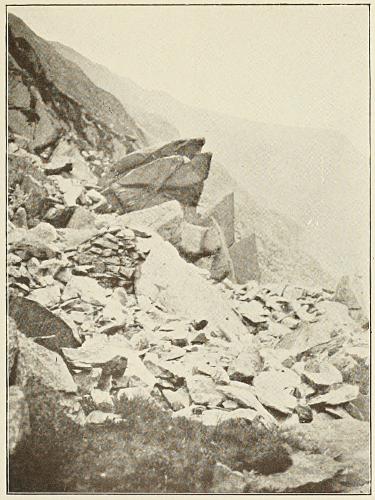
BROAD HOWE.
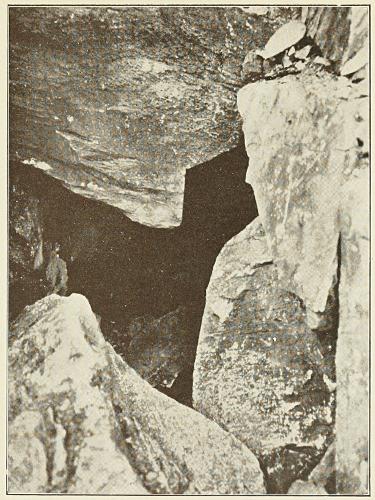
LOOKING INTO BROAD HOWE “BORRAN” FROM ABOVE.
The fell fox loves rough ground, and uphill amongst the rocks he is a match for the swiftest hound. He can climb like a cat, and can squeeze his lean body through a very small opening. When hard pressed by hounds, instead of going to ground, he will sometimes attempt to evade them by taking refuge on some narrow ledge or “benk” on the crags. When this happens there is always the danger that hounds in the excitement of fresh-finding their fox may fall from the ledges on to the jagged rocks far below. Although Reynard is[29] quite at home in such places, even he sometimes goes too far, and finds his retreat cut off, and an impassable route ahead of him. There he crouches until some too venturesome hound finds a way to him, and unless the hound catches and holds him on the ledge, one or other of them, if not both, will be lucky if they escape death by a fall.
I have seen a young hound fall with his fox from a height of two hundred feet, and I can assure you it is far from being a pleasant sight. This season, 1919, I watched a fox run by the Blencathra Hounds, take refuge on a blaeberry-covered ledge on a small crag. Hounds could wind him from the top, and at last one of them scrambled up from below and walked right on top of the fox. Reynard sprang up, the hound seized, but could not hold him, and I saw the fox fall backwards off the ledge as he wrenched himself free. Luckily the hound had sense not to follow. Reynard fell a matter of fifty feet, scrambled on to his legs again, and went off, though it was easy to see he was badly shaken by his fall. Not long after he went to ground, was ejected, and finally killed.
Hunting with the same pack on another occasion, I saw a fox climb the face of a steep crag overlooking Thirlmere Lake. Only one hound out of the four couples which were running him managed to make the ascent, the remainder going round and out to the top by a different route.
The fences on the fells consist of loose stone walls, and foxes often run the wall tops for long distances, both when hunted and when out on the prowl.
On bad ground the fox uses his brush to aid him when making a quick turn at speed, and also to correct his balance in descending a declivity. I once watched a big dog-fox descend a steep, frozen snow drift. He carried his brush straight up in the air, whilst he took short mincing steps on the slippery surface. At ordinary times he carries his caudal appendage straight out behind him, the tip inclined slightly towards the ground.
Both dog-fox and vixen may have a white tag to the brush, though I think there are more of the former than the latter with such white tips. A white-tagged brush is not at any rate, as I have heard it said, the invariable mark of a dog-fox.
Hill foxes vary a good deal in colour, from a light yellowish-red to dark red, with sometimes a good many grey hairs mixed with the rest. The “greyhound” fox often showed a lot of white about the fore legs, but modern foxes shade off from red to black. During the 1918 season the Coniston Hounds killed a fox with an abnormal amount of white about the front of its mask.
When driven off the fell, and hard pressed by hounds in the low ground, I have seen foxes take refuge in all sorts of places. Once on a roof, again[31] on the window-ledge of a cottage, in a coal-house, and one desperately hunted fox sprang into a stream in roaring flood, to be carried under a bridge. Dry drains are often used as lying-up places, and they also afford refuge for hunted foxes, as do rabbit holes.
Reynard has no hesitation in taking to the water when need be, and I once saw a fox twice swim across the high end of a small lake, when it might just as easily have skirted the water, though doubtless the close proximity of hounds had something to do with the animal’s decision. A fox can climb like a cat, and when jumping an obstruction he hardly ever does so straight. A tame fox, kept in a roomy stable, invariably sprang up the side of the wall and threw himself into the manger, rather than jump straight into the latter, which he could easily do. A fox is also like a cat in the matter of the proverbial “nine lives.” I have often seen one after a terrific underground battle with the terriers, finally drawn out to all appearances dead, or practically so. Thrown on the ground the carcass has suddenly come to life, and made a bold bid for liberty.
If forced to go to ground in a spot not of his own choosing, a hill fox will sometimes squeeze himself tight into a narrow crevice of the rock where he is unable to distribute punishment to the terriers, but is forced to take and endure it from[32] them. As a rule, however, Reynard takes good care to make his stand where he commands the upper position, the terriers having to go up to him face to face. When this happens, the dog often gets badly marked, until another terrier can get behind the fox and force him to change his ground. When run to ground even in a big earth, a hunted fox sometimes elects to bolt very quickly. I remember on one occasion watching a fox enter a very strong earth, and before hounds could get to the spot, it bolted, went to ground again a few yards further on, and finally bolted and made straight away, to afford a good hunt.
A sure sign that a fox in a rocky earth is shifting his position underground, and may show himself, is when the terriers cease barking, and hounds begin to rush about the “Borran.” A fox has an uncanny knack of escaping from hounds, even if they are practically all round him. In rough ground, particularly, he is an adept at making his getaway.
In long heather a fox will often lie very close indeed, until hounds hunt right up to him. Then when you see the members of the pack jumping above the heather, as if expecting to view their quarry, you can look out, for he is sure to be lying hidden somewhere close to you. He will do the same on the ledge of a crag if he thinks he can escape notice, but, as a rule, he is not long in[33] leaving his retreat. I remember on one occasion seeing a fox curled up on a ledge quite bare of cover, in a crag overlooking the Deepdale valley. Hounds were questing for a drag far below. I was talking to another man at the time, yet that fox lay there and never stirred even an ear. Finally, I threw a stone at it, which bounced off the rock above it, making considerable noise. Still that fox lay on, as if deaf and blind. The next stone, however, was better aimed, and it rolled a few feet right on top of the fox. That woke him up, and he tarried not on his going. He must either have been asleep, or could not have heard or winded us. There was a stiffish breeze at the time, which may have had something to do with it.
I have only once seen a breeding earth actually in a crag. The vixen had chosen for her retreat a crevice in the face of the rock; the ascent to which was by no means easy. That the cubs had been well fed there was abundant evidence in the shape of pheasants’ tail feathers, bones, etc. These birds had been caught and killed in the dale below, and had been carried by the vixen for a considerable distance. Dog-foxes fight amongst themselves; these battles no doubt taking place in spring, when they travel long distances to visit the vixen of their choice. I have in my possession the mask of a big dog-fox—he weighed over seventeen[34] pounds—with half the left ear gone, doubtless the result of a fight.
At his own pace a hill fox can go for ever, and it is when scent is rather permanent than strong that extra long runs take place. Even on the roughest fells there is always some ground where hounds can press their fox, and so by degrees get on good terms with him. It is the pace which kills, in addition to the superior condition of the hounds. If a fox has gorged himself overnight, and hounds find him early in the morning, he is not in condition to show them a clean pair of heels, for he cannot, like a heron, lighten himself by throwing up his food. The consequence is, if hounds get away on anything like good terms, they burst him in a very short time. On the other hand, if he has come from a long distance in search of a vixen, he is not likely to have let hunger draw him away from love-making, so should he be forced to run for his life he can do it on an empty stomach, and his course is likely to be in a bee-line back to his own country. Then, if scent is good, the pace will be a cracker, and many miles will be covered, ere he is rolled over or run to ground. It is in spring that most of the longest runs take place, when the dog-foxes are on love-making bent.
The pace of a fox is very deceptive. He moves with a gliding action that carries him swiftly over[35] the ground. One minute he is here, the next he is far away, and you wonder how the dickens he did it. Not long ago a hunted fox passed me on a road, so close I could have touched him with a stick. I stood stock still when I saw him coming, and he took not the slightest notice of me. His mouth was slightly open, his black-tipped ears flattened close to his head, and he carried his brush straight and stiff as a poker behind him. I could plainly hear his panting, and the sound of his pads on the hard surface of the road. He did not appear to be travelling fast, so smooth was his action, but he passed me like a flash, and was very soon out of sight.
The fell fox does not get his first experience of being hunted until later in the year than the date set for cub-hunting in the Shires. Somewhere about the first or second week in October he will be roused some morning by the sound of the horn, and the music of the pack. It will be lucky for him if scent is only moderate, for in all probability he knows little country beyond the particular mountain where he was bred. If he survives the day he will begin to think his old quarters are not so very safe after all, and by degrees he will lengthen his journeys until he becomes familiar with a much wider area of country. Next time hounds come he may lead them a merry dance, and if luck is once more with him, he will have[36] gained still greater confidence in his powers and knowledge of his beat.
That certain foxes manage to live to a great age there is ample evidence in the shape of old and almost toothless customers brought to hand. It is a matter for surprise that nearly all these old things are fat and in good condition. Probably as age weakens their powers they make up for it in cunning, and so manage to still secure an adequate food supply. Like human beings, very old foxes show a good deal of grey about the head, giving them a grizzled, worn appearance.
Although the hill fox does most of his wandering abroad at night, he may occasionally be seen in daylight. Not long since a fox walked almost the entire length of the Troutbeck valley, near Windermere, despite the fact that he was loudly halloed at by several people en route. One may travel the fells for years without setting eyes on a fox except when hounds are out, despite the ample stock of foxes which now inhabit the mountains.
During the last ten years I have not seen more than half a dozen foxes when I have been wandering about the hills, though, curiously enough, I saw one on three successive evenings not long ago, in all probability the same fox on each occasion. This fox was coming down off the hill en route to the low ground, at about the same time each evening. Of course, if you are shooting on the[37] high ground, or walking with a shepherd whose dogs are running about the fell, you may often chance to disturb a fox. I refer, of course, to old foxes, not cubs, which latter are often to be seen in the vicinity of their earths.
A big dog-fox bred on the fells, is no mean antagonist for a terrier; in fact, if the latter is a small one, it may on occasion meet death at the white fangs of the fox. Reynard is no coward; when forced to fight he can put up a terrific battle. In addition he can stand a lot of punishment.
That dread scourge, mange, seldom makes its appearance on the fells, and was unheard of until the importation of foxes from outside introduced it. There is no more horrid sight than a badly manged fox, hairless, and foul with disease.
Fell fox cubs are easy to rear, and make nice pets, but they must be kept scrupulously clean, and properly fed. I once gave a cub to a friend of mine, and it lived for over three years in captivity. It was kept in a stable, where an old pony shared the space. Pony and fox were great friends, and it was no uncommon sight to see the fox jumping on and off the pony’s back.
This fox became on quite friendly terms with a terrier, and on several occasions I photographed the two of them coupled together. The friendship made not the slightest difference to the utility of the terrier against other foxes, for on the day after[38] I photographed him and his vulpine pal, he ran a long wet drain and collared his fox at the end of it, hounds having forced Reynard to ground.
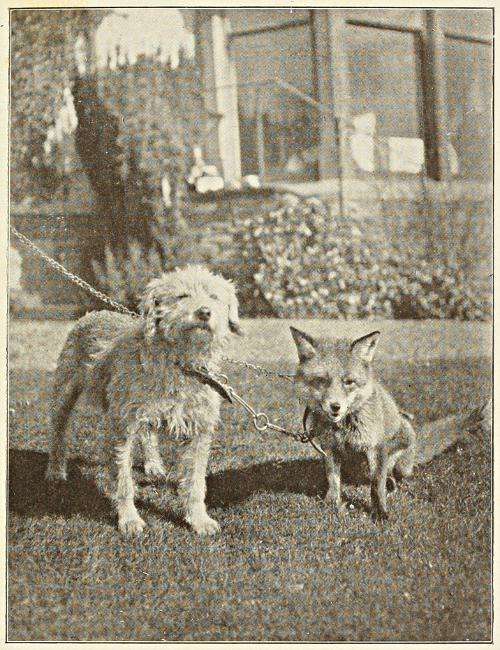
THE ARMISTICE.
“Kelly,” one of the Coniston Hunt terriers, and “Jacky,” a tame fox.
I have previously said that fox cubs are easy to rear, and in a way they are, depending, however, on their age when taken from the breeding earth. When very young, say two or three days old, they are quite helpless, being both blind and toothless. At this stage of their existence they should be fed on milk. If a rubber teat with a very small aperture is used, they will learn to suck warm milk through it. At first I used to give cubs diluted milk, but they seem to thrive on new milk quite as well. When very young, the body covering of a cub is mouse-colour, but even at this tender age the tiny tail—hardly to be called a brush—often shows a white tip. Very young cubs must be kept warm, otherwise they are apt to chill and die suddenly. As they grow older, artificial heat may be dispensed with. Cubs open their eyes fully when about three weeks old, and at first their eyes are bluish-grey in colour. At something over three weeks the eyes begin to assume the amber hue of the eyes of the adult, and the coat commences to turn from mouse-colour to brown. At five weeks the cub can walk in rather a wobbly sort of way, but the legs rapidly gain strength. From this stage onward,[39] cubs should be kept in a roomy kennel or other enclosure, as they become very active and playful, and delight in exercise.
When their teeth begin to appear, a small quantity of meat may be given them. Rabbit flesh with a bit of the skin and fur adhering to it is the best. After my cubs were big enough to take meat, they still preferred their milk by suction through a teat, and it required some patience and persuasion before they would lap from a saucer. They were fond of gnawing and playing with bones, and used to growl furiously if I interfered with their food. Absolute cleanliness of their abode is of vital importance if the cubs are to grow up healthy and well. Once they begin to feed heartily on meat, water is better for them than milk, and a clean supply should always be within their reach. In a wild state water is their only drink, and flesh, coupled with beetles, frogs, etc., their chief food. Mice, or, rather, field voles are the first creatures which the vixen teaches her cubs to stalk and kill. Both cubs and adult foxes devour quantities of these voles, and spend a good deal of time stalking them.
A fox stalks a vole in the same way that a cat goes about the business. Wandering along in the moonlight, on the prowl for anything edible, Reynard’s unerring nose warns him of the presence of a vole. A few paces ahead of him he sees the[40] grass stems moving, beneath which the tiny rodent is at work. Step by step the fox makes his noiseless approach, until, within springing distance, he halts, then bounds straight on top of the vole, nose and forepaws coming down together. A crunch, a swallow, and the tit-bit disappears down Reynard’s throat. It is only a morsel, but evidently a tasty one, otherwise the fox would not waste so much of his time in pursuit of mice and voles.
Any one who has watched a litter of well-grown cubs at play in a large enclosure, will discover how it is that a fox can so easily beat hounds for pace on very rough hill-ground.
I once spent several days watching and photographing seven young foxes—six dogs and a vixen—which were being reared to maturity in a kennel. The food of these cubs consisted of young rabbits’ carcasses slit open. Two or three cubs would seize a rabbit, and a tug-of-war ensued, generally ending in a free fight. One fox would fly at another, and so quick were their movements that the eye could hardly follow them. The favourite grip in such encounters appeared to be across the loins at the narrow portion of the back, though sometimes a throat hold took its place.
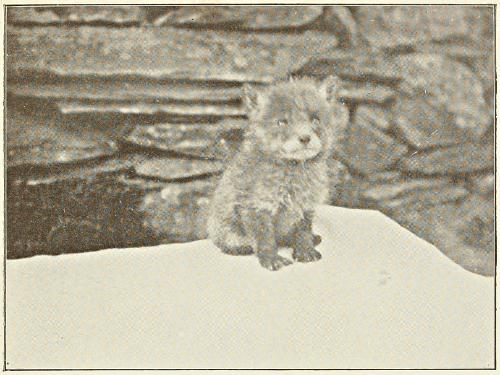
A THREE-WEEKS-OLD FOX CUB.
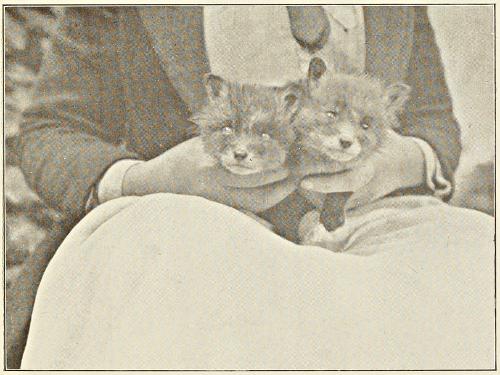
FOX CUBS, THREE WEEKS OLD.
As each cub secured its portion of food, it darted behind the nearest shelter, or sought a corner of the yard. Those not participating in the[41] struggle crouched down and watched the performance. If one cub approached another in hopes of sharing the feast, the feeding fox would growl furiously in defence of his tit-bit. The vocal sounds of these cubs were a sort of growl and hiss combined, a curious medley of dog and cat noises.
Occasionally one of them would bark, the sound being a sharp wow, wow, wow, the last note being longer drawn than the rest. On many a night in early spring I have heard the same sharp bark far up the fell side, where a dog-fox was calling to his mate.
I have more than once seen pictures of foxes “barking at the moon,” exactly as a dog does on a clear, moonlight night. These pictures always represented the fox with his nose pointed skyward, as a dog does when he howls. I have not seen a wild fox in the act of barking, but the cubs above mentioned invariably held their heads quite low, with nose slightly towards the ground. The only vixen in this litter was much tamer than her brothers, and never took part in any of the scrimmages, at feeding time. One of the dog cubs carried his brush much like a collie, with a decided curl at the tip. Probably in time, however, this curl would straighten out.
As these cubs were to be eventually turned down, they were in no way petted, and never[42] became really tame. The wilder they are before being given their liberty the better, from a hunting point of view.
Despite their furious battles, cubs can stand a tremendous lot of knocking about without sustaining any real hurt, and doubtless these struggles fit them for making their way in the world later in life.
Roughly speaking, the vixen lays down her cubs some time in March, though on the fells litters are apt to be later than in the low country. With a family of cubs to feed, it is not surprising that the fell fox now and then takes to lamb-killing. If rabbits are not fairly handy to the earth, and lambs are, the vixen will often pick up the latter when new-born, and carry them off. Sometimes she will kill more than she really needs, and then the farmer sends for the hounds, and a May fox dies.
If the vixen thinks that the whereabouts of the breeding earth has been discovered, she will promptly remove her offspring elsewhere, often to a much stronger and safer retreat.
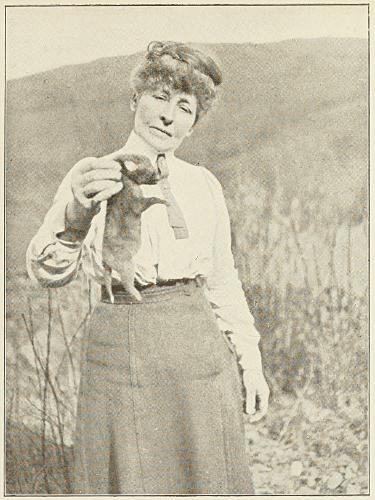
A DOG-FOX CUB, TEN DAYS OLD.
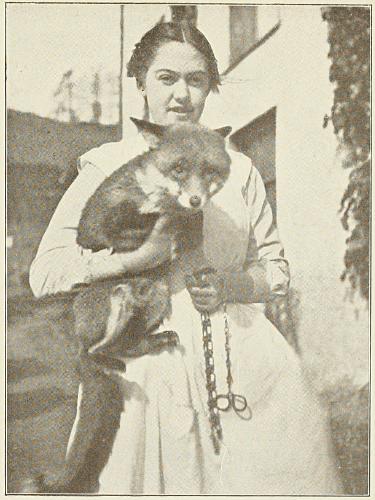
MISS HILDA CHAPMAN AND HER PET FOX, “JACKY.”
It is not surprising that foxes, being so remarkably active, are good climbers. I once paid a visit to four well-grown cubs in a roomy dog kennel, which was divided down the centre by iron railings. The lower half of this partition was covered with wire netting, and the cubs when at play used to fly up the wire and squeeze themselves[43] through the bars above. They would repeat the exercise again and again, appearing to thoroughly enjoy it.
Even in the low country it is no uncommon occurrence to find foxes lying up in pollard willows or other situations well above ground level. On the fells, foxes climb like cats, and can make their way anywhere amongst the crags. Foxes have been known to climb trees when hard pressed by hounds, but the little grey fox of America often does so in pursuit of birds and fruit, it being as much a fruit-eater as a consumer of flesh.
The grey fox is not a sporting beast; it prefers doubling and twisting to running straight, and soon goes to ground. It is more useful, however, than the Indian fox, which leaves no scent at all, and only provides sport when coursed.
Although foxes move about to a certain extent by day, most of their peregrinations are made during the hours of darkness. There is no doubt that a fox can see well in the dark, for his eyes are more like a cat’s than a dog’s. Taxidermists usually put dark eyes with round pupils in their mounted fox masks, whereas the real eye is amber-coloured, with veins, and a pupil which contracts to a narrow oval or ellipse. A mask so mounted has a much more foxy expression. I only know one firm of taxidermists who do really good work on fox masks, and that is Peter Spicer and Sons, of[44] Leamington. I can “spot” a mask done by them, out of any number of others.
I have heard it said that a fox dislikes travelling down wind when the latter is strong, because it blows his brush about, but in my own experience I have known foxes travel both up and down wind in a gale, and it did not appear to inconvenience them. As for not facing a strong wind, a fox will make his point on the fells so long as he can keep his feet at all. A fox stands much lower than a man, and the wind has not the same extent of surface to act upon.
As I have previously mentioned, a fox uses his brush to help him in turning quickly, and as an aid to balance. He also appears to use it when suddenly increasing his pace. Not long ago I saw a fox found by hounds, and he at once took to the rough ground, with the pack running in view. He soon outdistanced them, and slackened his pace, till the leading hound, which had not been saying much, owing to the steepness of the ground, suddenly shot into view. The fox saw the hound, and quickly altered his speed, while he swung his brush with a circular movement, as if using it like a screw to give him renewed impetus. I have seen a fox keep his brush revolving in a similar manner when very hard pressed by hounds downhill on steep ground, but under average conditions he carries it straight and stiff behind him.
The fell fox is always in better training than his relations in the low country, because he has, as a rule, much further to go in search of food, and his beat is a wide one. He is generally lean and hard, though now and then one comes across a fox carrying a certain amount of fat. A fox, like a hare, or any other hunted animal for that matter, if forced beyond the limit of his beat, is more or less nonplussed, and runs in an aimless manner. I remember a run of this kind in the 1918-19 season, when hounds killed a big dog-fox in the open. During the latter part of the run, this fox took refuge in a shed adjoining a house. Leaving this unsafe retreat, he travelled on, and, after passing a number of places where he could easily have got to ground, eventually lay down on the fell side. As hounds drew near he jumped up, and they never broke view till they rolled him over, stiff as a poker. It was plain to see he was in country strange to him, but the first part of the run had been very fast, and hounds had forced him downhill off his own range of mountains, and so to his eventual undoing.
During the war foxes increased on the fells, and, at any rate in the Windermere district, some of them have been found lying at a lower altitude than usual. Also the Windermere Harriers have not been hunting this season, 1919-20, so that foxes from the hills may have taken advantage[46] of the unusual quietude of haunts near the dales. The increase on the high ground has led also to foxes putting in an appearance in country some distance from the fells, where they have not been seen for many years.
The war was a handicap to sport on the fells, just as it affected hunting in the Shires and elsewhere. The shortage of horses was not, of course, felt, but with so many followers away at the front, huntsmen of the fell packs were obliged to work practically single-handed. A number of experienced hunters scattered about the fell tops are a great help to a huntsman, and the want of them is quickly felt. Now, however, all the fell packs are in full swing again, and prospects for the future appear rosy.
The hunting man from the Shires, on paying his initial visit to one or other of the fell packs, will no doubt be struck by the very different appearance of these hounds from those to which he has been accustomed.
For many years past Masters of hounds have bred for an exclusive type, as represented by the Peterborough standard. Unfortunately there are comparatively few hunting countries to which hounds of this exclusive type are exactly suited, yet, for various reasons, mainly financial, the majority of packs are composed of hounds very close to the standard.
A pack of hounds is got together with the object of showing sport and killing foxes. Throughout Great Britain the character of the individual hunting countries differs considerably. From the[48] Hampshire downs and the vale country of the Shires, we progress northward through varying types of country, until we reach the fells of Cumberland and Westmorland, which comprise some of the wildest and roughest ground in England.
Any one who has had much experience of riding to hounds in different countries knows that the type of horse suited, let us say to Cumberland, would be entirely out of place in Warwickshire, which is fairly representative of a sound grass country. Now a horse ridden by a man who means to see sport and be with hounds must cross the same line of country taken by the latter. If, therefore, to enable him to do this with ease to himself and his rider the horse should be of the correct type, is it not equally necessary, in fact more so, for the hounds to be of a type most suited to the requirements of their particular country?
I think those Masters who set utility in advance of fashion where their hounds are concerned, will agree with me when I express the opinion that a deviation in type from the Peterborough standard, in order to improve the sport-showing qualities of a pack, should enhance rather than militate against their financial value.
Unfortunately, nowadays, the reverse is the case. As an example, I will take a hound from each of three very different countries, i.e. the[49] Warwickshire, the Radnorshire, and the Blencathra.
The Warwickshire hound is of the fashionable type, and we will suppose his show value, in competition on the flags, is 100 points. The Radnorshire hound under the same conditions will be judged at say, 50 points, while the Blencathra hound cannot be allowed more than 25 points.
The financial value of these hounds would show an equally remarkable difference. If we credit the Warwickshire winner as worth 90 guineas, the Radnorshire hound will fetch perhaps 20 guineas, while the Blencathra representative we can set down for a sum of 3 guineas.
Examining their utility value in the same way, the Warwickshire hound may take the field four days a fortnight. He may continue to run up till his fifth or sixth season. The Radnorshire hound can, if required, do his five days a fortnight, and will probably be a runner-up until his seventh season. The Blencathra hound will come out three, if not four, days per week, and he has been known to do even more than this, whilst he will continue to run up till his ninth or tenth season, barring accidents amongst the crags.
The above comparisons tend to show how little real encouragement is held out to a modern Master of hounds to breed for utility and sport instead of exclusive type and consequent financial value.
The hound required to successfully cope with the exigencies of the fell country of Cumberland and Westmorland should conform to the following specification:—
Light in frame, and particularly well let-down and developed in hind quarters. Hare-footed, as opposed to the round cat-foot of the standard type. Good neck, shoulders and loin, long in pastern, and ribs carried well back. A good nose, plenty of tongue, and last, but by no means least, pace.
Owing to financial considerations, the fell packs are small, therefore individual hounds have to take the field much oftener than those composing the fashionable packs. They are kept, too, under less artificial conditions, and in consequence are quite able to run up for many seasons, and are seldom sick or sorry.
Although on the fells there is plenty of ground where hounds can race on a good scenting day, the majority of it consists of steep slopes, rock and loose shale, in addition to huge crags and cliffs. The fences consist of big stone walls.
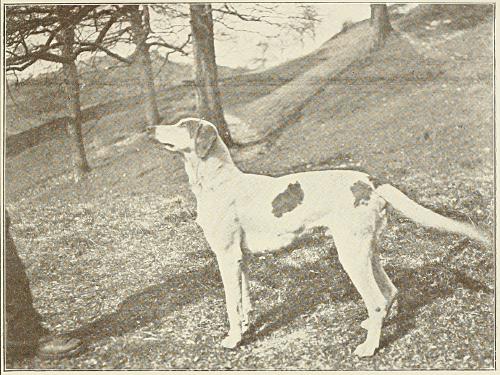
“CRACKER.” Late of the Coniston pack. A big hound of the fell type.
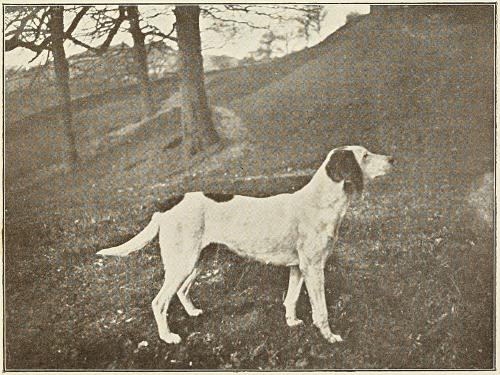
“MISCHIEF.” Late of the Coniston pack. A bitch of the fell type.
A hound of the exclusive type is absolutely unsuited to such a country, for the following reasons: His weight is against him, as well as his short, straight pasterns, and round cat-feet. Jumping from a height, or running downhill on rough ground, his pasterns, owing to lack of spring, fail to minimise jar and concussion; no matter how[51] good his shoulders may be. His round, over-developed, and practically malformed feet, are of little help to him either for crossing rough ground, or for gripping the latter when climbing crags and steep slopes. He is usually, too, lacking in tongue, and is not fond of working out a cold drag.
In addition, his height is against him when it comes to quick turning and running on steep ground.
A fell hound should stand under, rather than over, 22½ inches.
I know many people consider a big hound more suited to jumping high stone walls than a little one, but in practice it has been proved that the small hound crosses them with greater ease. To jump properly a hound should be short-coupled, compact in build, and have his ribs carried well back. You find this to more perfection in a small hound than a big one. The short-coupled hound can get his hind legs much further under his body, and, in consequence, clears an obstacle with far less strain. Jumping off a wall, too, the light-built hound experiences less jar on landing. At the end of a long day, the light-built hounds of a pack will show less signs of fatigue than those of greater weight, and will return to kennels with their sterns gaily carried. Weight increases leg weariness, and shortens the length of a hound’s utility in the field.[52] Until the craze for show competition has run its course, both hounds and gun-dogs will suffer from it. Working ability should be the main object of the man who breeds for sport, and if he crosses workers with workers, Nature will see to it that beauty and good looks suited to the particular type will eventually accompany that ability. It is much better to do this than allow the beauty standard, or perhaps I had better say the humanly-conceived type of beauty, to take preference of working capabilities.
One of the most important points about a hound is his feet. Without sound feet he is severely handicapped from the very beginning. Many hounds of the exclusive type are so handicapped, their feet being nothing less than malformed. Owing to the shortening and cramping up of the feet, and the knuckling over at the knee, a hound of this type is useless for work in rough country.
On the fells, where hounds are bred for work and not for show, the natural or hare-foot is universal. Possessed of a lengthy surface, weight is evenly distributed along the latter, while wear and tear on the foot is properly taken up. Such a foot gets a firm grip on rocks, and offers a smooth surface to the ground on steep descents. If to such a foot we add a long, sloping pastern, jar and concussion will be brought to a minimum,[53] particularly if the shoulders are also good. Concussion acts through the nervous system on the brain, and, therefore, the working life of a hound is quickly shortened, should he be improperly constructed as regards his feet. In most kennels, the dew-claws are removed from the puppies when the latter are quite young. The fell hounds, however, retain this claw, and it is properly developed. Far from being a useless appendage, as many people imagine, the dew-claw is of assistance to a hound in surmounting slippery rocks, where he has to pull himself up. It also acts as a preventative to slipping on the ledges of the crags. Was there no use for this claw it would not develop as it does on a fell hound, and on examination it will be found to be worn on the underside of the nail, proof positive that it does its share of work.
I have already mentioned the fact that there are portions of the fell country where hounds can get up a tremendous pace, and so severely press their fox at some period of a run. If the forearm of a hound is properly put together, not only will the several parts help to minimise jar and concussion, but they will give the hound an increased capacity for speed. If the humerus or bone of the upper arm is nearly in a straight line with the ulna and radius, the pace of the hound will be much greater than if the humerus inclines at a sharper angle.
What is commonly known as a “loaded shoulder” is the result of the humerus inclining to a nearly horizontal position, forming an obtuse angle between itself and the scapula or shoulder blade.
The angles formed by the scapula, humerus, and radius are filled with muscle and tissue, which act detrimentally to the forward movement of the leg, the result of which means loss of pace.
In the same way with regard to the hind leg, the longer the femur the lower the hock, and the greater the speed. The more obtuse the angle between the femur and tibia, the more power is there to bring the hind legs well under the body, as well as to throw them back.
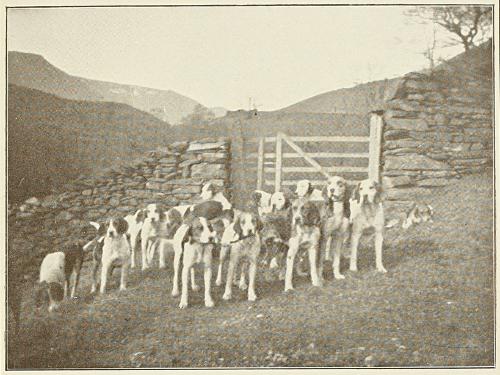
CONISTON FOXHOUNDS: THE PACK.
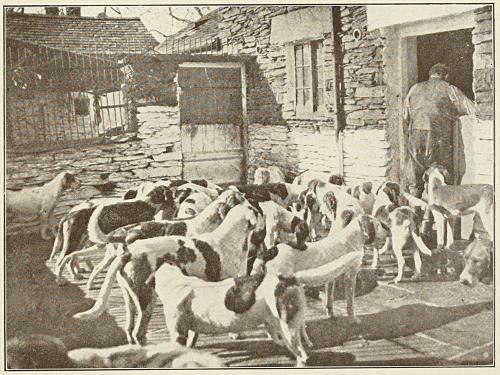
CONISTON FOXHOUNDS: THE PACK IN KENNELS AT GREENBANK, AMBLESIDE.
To sum up the desired qualities in a fell hound, we have light frame, light bone, good neck and shoulders (these can’t be too good), good ribs, loins and thighs, and last, but not least, sound feet of the hare type. Given a good nose and a capacity for throwing his tongue, such a hound will work out a cold drag, and then, after unkennelling his fox, will drive ahead at a tremendous pace. I have often heard it stated that pace is not compatible with nose, but I think any one who has had a season or two with one of the fell packs will be in a position to easily refute such statements. Hardly a season passes without some individual hound of one or other of the fell packs finding, hunting, and[55] killing a fox “on his own.” No single hound could do that in a country like the fells unless he possessed nose, pace, drive and courage in a marked degree.
The majority of the fell hounds are light-coloured; some of them practically white. This is a decided advantage on the hills, where it is impossible to keep in close touch with them. A light-coloured hound can be seen at a great distance against a background of heather or dark rock. Next to nose, however, music is most important. Even if you cannot see hounds, yet can hear them plainly, you know what to do, and which direction to take.
Hunting on the fells necessitates practising the “let ’em alone principle,” for throughout the majority of runs hounds do all their own work unaided by their huntsman. Thus they learn perseverance, which enables them to carry on when scenting conditions are not of the best.
Harking back for a moment to the subject of hound conformation, I have always been surprised that judges at the shows appear to set little or no store by the shape of a hound’s hind feet. Even with the ultra-fashionable type the hind feet are more or less as Nature formed them, and they stand wear and tear without showing signs of breaking up.
Now, this is a perfect refutation of the idea[56] that the over-developed round cat-foot is the best and most desirable. Surely when a hound standing on four feet turns the front ones in, and knuckles over at the knee, at the same time showing general inability in those feet to withstand hard wear, yet suffers from no ill effects in the hind feet, one would imagine that a judge with a modicum of common sense would see the futility in continuing to breed hounds with fore feet of the fashionable type. No, fashion prescribes such feet, and though when you wish to sell them fashionable hounds fetch big prices, their upkeep as a pack costs you ten times the amount that it would for a pack possessing sound natural feet of the hare or semi-hare type.
Whilst there are one or two countries where the cat-footed hound can travel with comparative comfort to himself, there are many more where he very soon becomes lame, and ceases to be a really useful member of the pack.
The Master who is really fond of hound work, and wishes to show sport, naturally breeds hounds suited to his particular country; that is, if his financial resources are equal to the strain. Should he by ill luck experience severe losses in his kennel, he will find great difficulty in procuring fresh hounds suited to his needs, for probably all the hounds available are of Peterborough type.
Again, should he wish to sell his pack, despite[57] the fact that the hounds are perfect in their work, they will fetch comparatively little, as they are not up to the fashionable standard in looks.
All this could be avoided if the show standard was considered from the point of view of the suitability of the hound to its particular country. Masters could then afford to breed hounds with this object, knowing that when they wished to get rid of them they would fetch a sum commensurate with their working ability.
It has often been stated that hounds require blood to keep them keen and up to the mark. Now, I think there are few hounds keener than those which hunt the fells, yet they seldom, if ever, break up their foxes in the accepted sense of the word. Now and then I have seen hounds break up and eat the greater portion of their fox, but, as a rule, they are content to kill it and leave it at that. American-bred hounds never get blood, yet they hunt season after season as keenly as English hounds which are “blooded up to the eyes.” During a long sojourn in Canada, I met and corresponded with a good many keen hunting men, quite a few of whom had imported English hounds to that country and the States. Much of the hunting country out there is very rough, and hounds are hunted on foot, or ridden to by nicking in and making for likely points. All the American foxhunters I got in touch with were emphatic in[58] their denunciation of the Peterborough type of hound, yet they had imported fell hounds, which exactly suited their requirements, and crossed well with the native-bred hounds.
It is curious, but, nevertheless true, that in England when a low-country pack run their fox to the hills they often lose him, but let the fell hounds force their fox off the fells down to the low ground and they generally kill him. The fell hounds, accustomed to do most of their work on more or less precipitous ground, no doubt feel as if they were having a day off, as it were, when they descend to the level of the dales, whereas it is the other way round with the hounds of the lowland packs. In summer the fell hounds go out to walk at the farmhouses and other places in the dales, and are brought back to kennels in the hunting season. Although a pack of fell hounds can hunt and kill a fox in any description of country, which is more than can be said for the fashionable sort, “hounds for countries” should be the breeders’ motto. Hounds could be quite as easily judged on this principle at the shows as they are now, by always keeping in mind the ideal of working conformation.
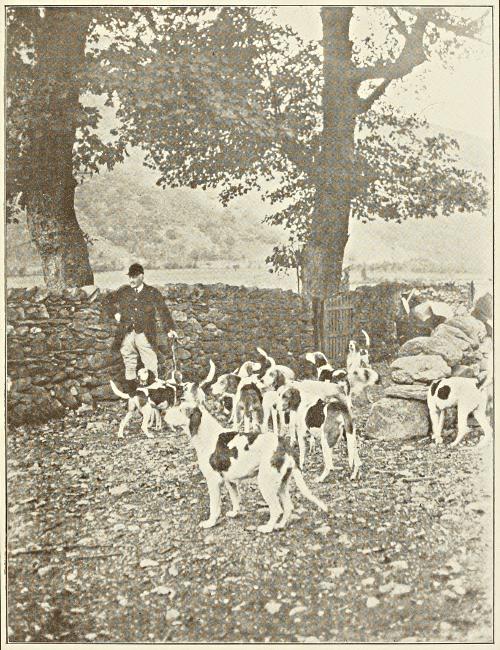
ULLSWATER FOXHOUNDS: THE PACK WITH THEIR HUNTSMAN.
In every country there are men able to judge a collection of hounds from the view-point of real utility in that country, and as there are many countries in which the same type, or practically the[59] same type, is suitable, there should be no difficulty in securing proper awards.
Fell hounds are, owing to the roughness of their country, far more liable to accidents than hounds which hunt the low ground. Considering the dangerous nature of their work, it is really surprising how comparatively few serious accidents occur. A severe loss through distemper or other causes is more to be feared, as it takes time and patience to fill the gaps thus made in the pack. All the fell packs are small, and seldom, if ever, have hounds to spare, and few outside packs possess hounds of a type in the least suited to the country; so the fell-country Master has to rely on hounds of his own breeding. There is one temptation to which fell hounds are more liable to fall than low-country hounds, i.e. sheep worrying. It may be a wild, windy day, and hounds are on a catchy scent, and eager to be pushing on. No one is near them, and perhaps a young hound happens to view a solitary Herdwick sheep scurrying off. He gives chase, pulls down the sheep, and his example may be followed by several others. When this happens the huntsman is reluctantly forced to put down the culprits, no matter how short of hounds he may be at the time.
Although, luckily, such a contretemps as the above seldom happens, it is always liable to happen with certain young hounds. Death is the only cure for[60] a hound which takes a liking to mutton on the hoof, for he can never be thoroughly trusted afterwards.
In judging the appearance of a hound from a utility view-point, many people are apt to pay much more attention to the fore limbs than the hind. This is a great mistake, for pace, freedom of action, and power to overcome obstacles, such as high stone walls, are much more dependent on the hind limbs than the fore. The power which enables a hound to spring up a high bank, or heave himself on to the top of a wall, is entirely developed from the hind quarters, and, as I have already mentioned, the small, compact hound that can get his hocks well under him is much better fitted for jumping than the big hound. In judging the hind quarters, particular attention should be given to the muscular development of the second thigh as well as to the same development of the inside of the leg. A tendency towards “cow hocks,” i.e. a deviation from the straight line between the hock and ground, should be condemned. A “cow-hocked” hound lifts his hind quarters higher than he should at each stride when travelling fast, the reason being a want of flexion due to shortened tendons inside. In other words, the more acute the angle between the foot and the stifle joint the shorter are the tendons that work the feet. This means reduced spring in the latter, and a consequent loss of propulsive power.
To return for a moment to the fore limbs. I have said that if the humerus or bone of the upper arm is nearly in a straight line with the ulna and radius, the pace of the hound will be much greater than if the humerus inclines at a sharper angle, or, in other words, lies in a more horizontal position. Whilst this formation ensures a lengthier stride, and consequent increase in pace, it also tends to increase shock, or jar and concussion. This jar is communicated to the hound’s head through the top of the scapula or shoulder blade. In order to reduce this jar to a minimum the scapula should lie well back, in an oblique position. The scapula or shoulder blade connects with the dorsal vertebræ, or bones of the back, and it can be easily understood that the further from the head this point of connection is the less jar will be communicated to the hound’s brain.
Having mentioned some of the more important parts of a fell hound’s anatomy, we may turn to his nose, or scenting power. The latter is the most important quality in a fell hound, for no matter how well-built he is, without nose his utility is nil. I have heard it said by people who should have known better, that pace and nose are incompatible. A very short experience of sport with the fell packs will enable any one to refute such a foolish statement. To press a fox in the rough fell country hounds must have pace, drive, and courage to an[62] unusual degree. The records of foxes killed in any one season will testify to their qualities in the above respect, while their powers of owning a stale drag leave no doubt concerning their noses. The reason why the fell hounds possess great scenting power is because of the way they are bred, and also owing to the fact that they do practically all their work unaided, and thus become persevering and absolutely self-reliant. This leads to a high development, through constant use, of the powers with which they are naturally endowed.
It is commonly understood that the fashionable hounds in the Shires are second to none for pace. Whilst they may be fast, I doubt very much if they can equal, let alone surpass, the fell hounds for speed. The moorland hounds in Yorkshire are of the same type as our fell hounds, and sportsmen in the “county of broad acres” are quite as keen on hound trails as are the men of the Lake country.
A little story from Yorkshire, concerning the speed of hounds, may, therefore, be worth repeating.
On one occasion, Bobbie Dawson, huntsman to the Billsdale, went to a fixture of the Sinnington pack, taking with him one of his own hill hounds, by name, “Minister.” After trying for some time, hounds failed to find a fox, so Bobbie took “Minister” to a little covert, where the hound found a fox, coursed it and killed it in the open. Jack Parker, the Sinnington huntsman, was rather[63] annoyed at this, and when Bobbie Dawson said, “Mun we kill another?” he replied, “Aye, if you can?”
Bobbie, therefore, made off to another covert, where “Minister” again found a fox, and ran him well ahead of the Sinnington hounds, finally rolling him over like his predecessor. The Sinnington broke him up, as “Minister,” being a hill hound, would not touch him after he was dead.
This took place in the low country, and shows what a hill hound can do when he finds himself on more or less level “going.”
I have heard it said that the fell hounds would be beaten by hounds from the Shires in an enclosed country, but I should feel pretty safe with my money on a fell pack, if ever such a trial took place.
In order to get the best out of hounds, their feeding and conditioning should receive very special attention. It is the superior condition of the hounds that enables them to press their fox at some period of a run, and by doing so, eventually bring him to hand. Both scenting power and eyesight may be damaged in a hound solely through injudicious feeding. A great deal too much “slop” is fed to hounds in some kennels, the result being that hounds in their eagerness to feed, shove their muzzles well into the liquid, and not only get irritating matter up their nostrils, but splash their eyes into the bargain. The nostrils are extremely[64] tender, and anything lodging in them tends to set up irritation and inflammation, with the result that the animal cannot use its nose to the best advantage in the field. In the same way, particles of irritating matter reach the eyes, the latter, as in humans, being most susceptible to anything of such a nature. Fed with solid food early the day before hunting, hounds should be fit to run their best on arrival at the meet. Hounds well fed with good stiff food will work better, and keep in better condition, than those which are blown out with sloppy feed. Due attention should, of course, be paid to the gross feeders and those with more dainty appetites, but the chief thing to remember is the stiff food.
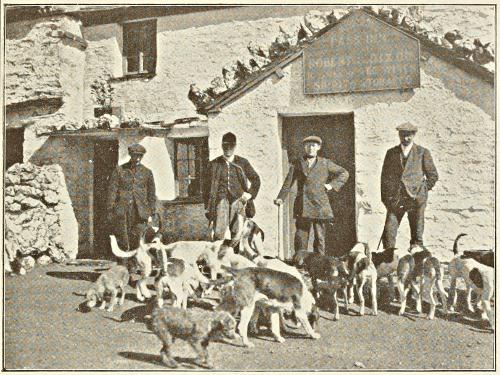
CONISTON FOXHOUNDS: AT THE “TRAVELLERS’ REST” INN, ON THE SUMMIT OF THE KIRKSTONE PASS (1469 FT.).
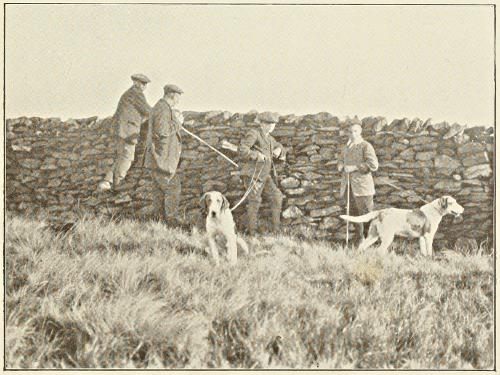
CONISTON FOXHOUNDS: WAITING FOR THE PACK ON THE FELL.
On the return from hunting it is, I think, bad policy to allow hounds to absolutely gorge themselves, just a nice feed being much better, and less liable to cause internal disorders such as indigestion. Old hounds which, owing to their experience, are so valuable in a fell pack, should, with advancing years, be fed lighter than was the case in their younger days. An old hound is like a human being, apt to put on fat internally with age, and though he may not show it markedly in his outward appearance, such fat has a deleterious effect on his wind. Over-feeding only increases this fat, and though the hound may be able to stay almost as well as ever, a fast burst over a country finds[65] him tailing behind his fellows. Quality of food, and thickness—in fact, the thicker the better—has everything to do with hounds keeping their condition. It should never be forgotten that the superior condition of the hounds over that of the fox, is the chief factor in enabling them to bring their quarry to hand.
The fell hound, like his relations in the Shires, is sent out to walk as a puppy. A great deal depends upon his treatment during this period of his existence. The majority of fell hounds are walked at farmhouses, where they are assured of sufficient liberty, and become accustomed to knocking about amongst sheep, thus quickly learning that mutton on the hoof is strictly taboo to a hound.
When out on the fell with the shepherds, the puppy soon learns to chase hares, which teach him to get his nose down and hunt. He may also get to know the scent of a fox long before he becomes a working member of the pack. The shepherds’ cur dogs often unkennel foxes on the fells, and occasionally roll them over.
A sharp cur dog is much handier and quicker than the fastest hound in rough ground, and generally possesses an excellent nose; therefore, if Reynard gets up close in front of such an one, it means a close shave if nothing worse.
After the dispersal of the Sedbergh Foxhounds,[66] a party of farmers were gathering sheep in the vicinity of Cautley Crag, when one of their dogs unkennelled a fox. Four other curs joined in the chase, and after a sharp spin, the fox was rolled over. On proceeding further up the fell, still another fox was disturbed, and the same quintet of dogs repeated the performance, killing their fox after a sharp scurry. I have seen a cur dog lead hounds in a fast hunt, and be in at the finish when the fox met its death in the open. A cur dog can twist and turn at a wonderful pace amongst the rocks, and can climb at a surprising rate.
To return for a moment to the subject of hound food. Hard feed not only ensures condition, but is a safeguard against eczema. Sloppy food induces the latter, and without a doubt aggravates mange. Hard food is better for the teeth, and by causing a flow of saliva, as hounds have to chew it to some extent, it digests better.
Hounds from both the fells and the Shires have from time to time been purchased and imported by Americans. Except in the East of America, the Peterborough type of hound has found little favour. On the contrary, the fell hounds have been well received, and cross nicely with the native-bred hounds.
The country, and the method of hunting in many of the American states, is on similar lines[67] to that on the fells, so the imported hounds find themselves more or less “at home.” Col. Roger D. Williams, M.F.H. (Iroquois Hunt Club, Kentucky), in his book “Horse and Hound,” has this to say, when comparing sport in England and the States:
“The problem that confronts the American hound is an altogether different proposition. Our coverts and forests are extremely large, the foxes remaining wild and timid, and seldom pass twenty-four hours without a run of from four to eight hours, the hounds frequently running them by themselves without hunters (unless the packs are large they are not kennelled and generally run at large).
“One or two ambitious hounds will alone get up a fox at dusk, and as they circle through the neighbourhood all the hounds in hearing ‘hark’ to them until ten or a dozen couples are hustling him in full cry. Does the fox go to earth? Not he, earth stoppers are unnecessary; he will lead them a merry chase as long as he can drag one foot behind the other, or until daylight warns him he had better ‘seek the seclusion that his burrow grants.’ I have, upon more than one occasion in the ‘Blue Grass Country,’ heard two and three different packs in the middle of the night, each one after a different fox, making music that would cause the blood to go galloping through one’s veins like a racehorse.
“Thus at any time his ‘foxship’ is trained to the minute.
“The character of the country hunted over is frequently dry and rocky, many large ploughed and cultivated fields, with woodlands strewn with dry, parched leaves. It is not uncommon for hounds to hunt half a day before a trail is struck; it may then be an old, overnight trail that will require hours of persevering work before the fox is afoot.
“I am prepared to state that a hound that would be considered a wonder in the grass countries of England, if cast with a pack in America in our Southern States, where he would be expected to take a trail many hours old, in a dry, barren, country, puzzle it out for several hours, make a jump (unkennel), and then run it from ten to twenty hours—a feat I have seen performed scores of times by American hounds—would find himself hopelessly out of a job.”
That the imported fell hounds have found favour in America is corroborated by two “At stud” advertisements in a copy of the Red Ranger—an American publication devoted solely to foxhunting—which I have before me as I write.
The date is February, 1913, and the “ads.” are as follows:—
“At stud. ‘Ringwood,’ a full-blooded Eskdale foxhound, bred by William Porter. A wide and[69] rapid hunter, an excellent trailer, fast and dead game. Ship bitches to Woodland, Ga. All communications to A. G. Gordon, Junr., Talbotton, Ga. Stud fee, $35. Cash.”
The other advertisement reads as follows:—
“At stud. ‘Streamer,’ the imported Eskdale dog. Fee, $25. The one source of new blood for all American strains of hounds that you know is right. Write for description, etc., to Thomas Hackley, Stanford, Kentucky, R.F.D. 1.”
Except, as I have previously stated, in the East, American foxhunting conforms to sport on the fells and the moorlands in England. Hounds do their work quite unassisted, and so become persevering and independent.
Whilst financial considerations necessitate small packs in the fell country, lack of numbers is made up for by the ability of hounds to come out three or even four days per week. Hounds are not kept under artificial conditions, and so grow hard and healthy, seldom suffering from any sort of complaint.
No description of fell hunting would be complete without a reference to John Peel, the famous Cumbrian Master and Huntsman.
Although Peel was well known in his own country, his fame did not extend beyond the North, until the old song, “D’ye ken John Peel?” became popular. The spirited verses had little vogue until after Peel’s death in 1854, when the song suddenly became fashionable. The original song differs in some respects from the modern version, particularly in the first line. “D’ye ken John Peel with his coat so gay?” is sung to-day, whereas the original is, “Did ye ken John Peel wi’ his cwote seay gray?”
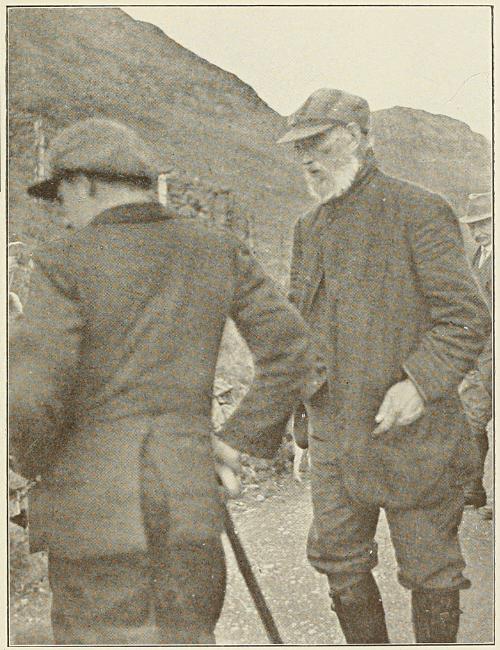
BLENCATHRA FOXHOUNDS: ON RIGHT, GEORGE TICKELL, ESQ., EX-DEPUTY MASTER (1907-1919).
Peel never wore a scarlet coat, his jacket was made of home-spun Cumberland wool, known locally as “hoddengray.”
The late Mr. Jackson Gillbanks, of Whitefield, gave a good pen-picture of John Peel, and I take the liberty of quoting it here. He said—
“John Peel was a good specimen of a plain Cumberland yeoman. On less than £400 per annum he hunted at his own expense, and unassisted, a pack of foxhounds for half a century. John has in his time drawn every covert in the country, and was well known on the Scottish borders. Except on great days he followed the old style of hunting,—that is, turning out before daylight, often at five or six o’clock, and hunted his fox by the drag. He was a man of stalwart form, and well built; he generally wore a coat of home-spun Cumberland wool—a species called ‘hoddengray.’ John was a very good shot, and used a single-barrel, with flint lock, to the last. Though he sometimes indulged too much, he was always up by four or five in the morning, no matter what had taken place the night before; and, perhaps, to this may be attributed his excellent health, as he was never known to have a day’s sickness, until his last and only illness.”
Mr. Gillbanks was also the author of the[72] following verses, published in the Wigton Advertiser:—
The late Sir Wilfrid Lawson also gives a good description of Peel. He says:
“I have seen John Peel in the flesh, and have hunted with him. He was a tall, bony Cumbrian,[73] who, when I knew him, used to ride a pony he called ‘Dunny,’ from its light colour, and on this animal, from his intimate knowledge of the country, he used to get along the roads, and see a great deal of what his hounds did. Peel’s grey coat is no more a myth than himself, for I well remember the long, rough, grey garment, which almost came down to his knees. No doubt drink played a prominent part—if it were not, indeed, the ‘predominant partner’ in these northern hunts. I have heard John Peel say, when they had killed a fox: ‘Now! this is the first fox we’ve killed this season, and it munna be a dry ’un!’—words of that kind being a prelude to an adjournment to the nearest public-house, where the party would remain for an indefinite time, reaching, I have heard it said, even to two days.”
In the book “Sir Wilfrid Lawson (A Memoir),” by the Right Hon. George W. E. Russell, it says:
“The famous John Peel, who is ‘kenn’d’ over the English-speaking world, was a Master of Foxhounds on a very primitive and limited scale, and hunted his own hounds in Cumberland for upwards of forty-six years. He died in 1854. By this time Wilfrid Lawson was twenty-five years old, and desperately fond of hunting. So, on the death of John Peel, with whom he had hunted ever since he could sit in a saddle, he bought Peel’s hounds, amalgamated them with a small pack which he[74] already possessed, and became Master of the Cumberland Foxhounds.”
The famous song, “John Peel,” was written by Woodcock Graves, an intimate friend of Peel. Graves emigrated to Tasmania in 1833, and spent the last years of his life there, far from the hunting country of his younger days.
John Peel was born at Grayrigg, and in later years lived at, and hunted from, his cottage at Ruthwaite.
The hunting man desirous of having a few days’ sport on the fells, can take his choice of five packs, i.e. the Ullswater, Coniston, Blencathra, Eskdale and Ennerdale, and the Mellbrake. The Ullswater hounds are kennelled at Patterdale; nearest railway stations, Penrith and Troutbeck (Cumberland). Mr. W. H. Marshall, of Patterdale Hall, is Master, and Joe Bowman is huntsman. Whipper-in, B. Wilson.
The Coniston are kennelled at Green Bank, Ambleside; nearest station, Windermere. Mr. Bruce Logan, of “Westbourne,” Bowness, is Master, and George Chapman is huntsman.
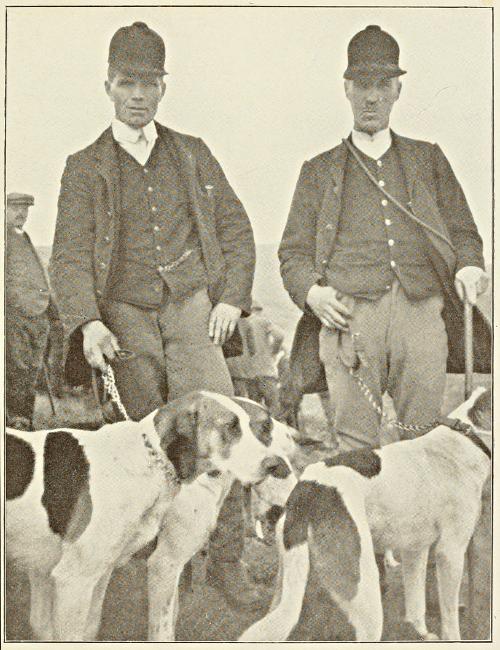
FELL COUNTRY HUNTSMEN.
The Blencathra are kennelled at the Riddings, near Threlkeld; railway stations, Threlkeld and Keswick. Master, Mr. R. J. Holdsworth, Seat Howe, Thornthwaite, Keswick. Deputy Master, Mr. Andrew Anderson, Lair Beck, Keswick. Secretary, Jonathan Harryman, Howe, Portinscale,[75] Keswick. Huntsman, Jim Dalton. Whipper-in, E. Parker.
The Right Hon. The Speaker (Mr. J. W. Lowther) was Master of the Blencathra from 1903 to 1919. He resigned the Mastership in 1919.
Mr. George Tickell, of Shundraw, Keswick, was Secretary for fourteen years, and on the death of the late Mr. John Crozier, who was Master from 1839 to 1903, he held the Mastership until the appointment of Mr. J. W. Lowther. He then acted as Deputy-Master from 1907 to 1919, when he retired.
Mr. Tickell has hunted regularly since he was a boy at school, thus covering a total of nearly seventy years. He is still (1919) hale and hearty, and regularly attends the meets of the Blencathra.
The Eskdale and Ennerdale are kennelled in Eskdale. Master, Mr. W. C. Porter, Field Head, Eskdale, R.S.O. Railway station, Ravenglass. The late Tommy Dobson was Master of this pack from 1857 to 1910. Huntsman, the Master.
The Mellbrake are kennelled at Hope Lorton. Masters, Mr. Robinson Mitchell, Mr. E. A. Iredale and Mr. D. B. Robinson. Secretary, Mr. R. Rawling, Lanthwaite Green, Cockermouth. Huntsman, R. Head. Whipper-in, J. Norman. Nearest railway station, Cockermouth.
The Mellbrake and the Eskdale and Ennerdale are somewhat isolated from the other Hunts, but[76] it is often possible to attend meets of the Coniston, Blencathra and Ullswater during the week. Once or twice a season the Blencathra visit Wythburn, at the head of Thirlmere Lake, where they remain for the inside of a week. If during that week the Coniston and Ullswater are in their home countries, they can easily be reached from Windermere or Ambleside, by motor or cycle. If the visitor wishes to put in most of his time with an individual pack, he will find comfortable hotels and inns within easy reach of the kennels. There is, of course, a good deal of luck about hunting anywhere, but particularly so on the fells, where weather conditions are apt to interfere with sport. The fell packs usually account for from fifteen to twenty-five brace of foxes in a season, the number, of course, varying with the character of the seasons. In the 1918-19 season, the Ullswater brought to hand close upon thirty-five brace, while the other packs all did remarkably well. Considering the roughness of the country, such records are very good indeed.
Joe Bowman, the veteran huntsman of the Ullswater, is a personality in Lakeland hunting. He has carried the horn with this pack—with one short interval—since 1879, and is still hale and hearty. His fame as a huntsman reaches far beyond the borders of his own wild country, for he is well known to most keen hunting folk.
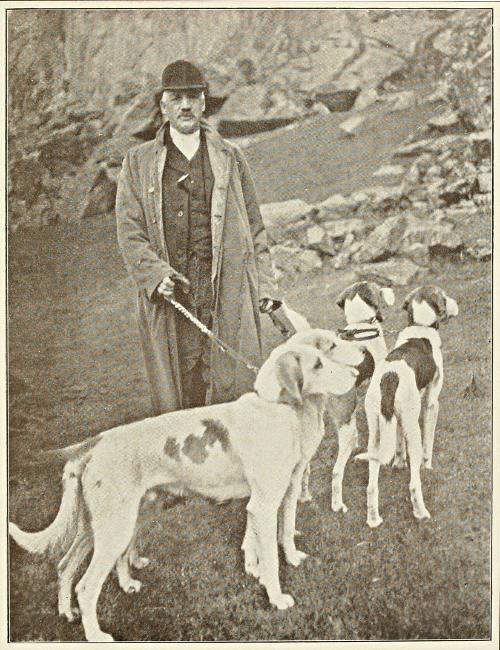
ULLSWATER FOXHOUNDS: JOE BOWMAN, THE HUNTSMAN.
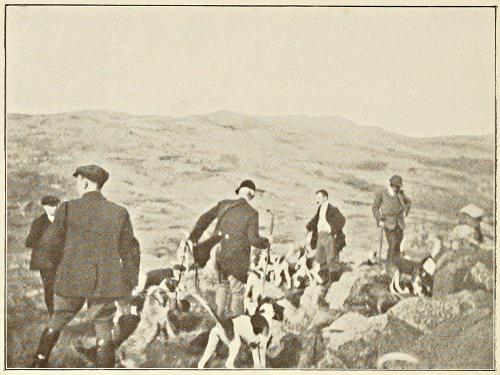
BLENCATHRA FOXHOUNDS: GONE TO GROUND ON ARMBOTH FELL.
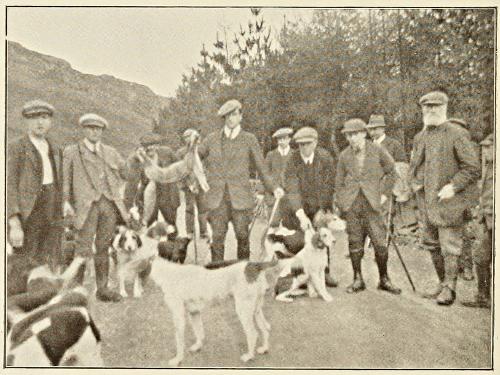
BLENCATHRA FOXHOUNDS: AFTER A KILL AT RAVEN CRAG, NEAR THIRLMERE LAKE, NOV. 7TH, 1919.
Except in certain parts of the low country, which are visited once or twice a season, riding to the fell hounds is out of the question. Even in the aforementioned districts it is a case of riding to points, and nicking in with hounds when the opportunity presents itself. There are places where, should you be lucky, you may chance to see the best part of a run from a main road below the fell. Such a place is the road which circles Thirlmere Lake, from which I have watched many a good hunt with the Blencathra. As a rule, however, it pays best to climb the fell, from which vantage point you are more likely to keep in constant touch with hounds. If you hang about the roads hounds may come back to you, but again they may not, and it requires a good deal of patience and self-control to remain where you are on the off-chance. Once on the fell top, it pays to stay there until hounds either drive their fox for the last time into the dale or run him to ground in some rocky “borran” (earth). It is much easier and quicker to walk round the fell tops than descend to the dale and have to climb out again.
In addition to the type of hound used, the method of hunting on the fells differs from that in the riding countries. There hounds are thrown into covert, from which in a few minutes they get away almost on top of their fox. While the same[78] thing sometimes happens with the fell hounds, as a rule, their fox is lying in some snug kennel at a height of two thousand feet or more, and before hounds can run him they must find him. To do this they quest for the drag, or in other words, they search for and pick up the line of a fox which during the night has visited the dale, and then before daybreak has returned to his mountain fastness. If the fox has cut his return trip rather fine, and hounds are out early, as they very often are in spring, the drag may prove a warm one. If it is cold and the fox long gone, it may require a lot of working out.
Anyhow, the same end is eventually attained, i.e. hounds gradually work up to the spot where their fox is lying. It may be on the ledge of some crag, or amongst the rocks strewn about the fell breast. Wherever it is, Reynard may wait till hounds are close to him, or he may steal away and, if unseen, gain a long start. As a rule, however, there are a few keen hunters scattered about the fell tops before hounds leave the dale, and the fox is lucky if he can slip away without the sharp eyes of some shepherd spying his movements. A series of shrill view-halloas soon bring hounds to the spot, and the run begins in earnest. Although such a halloa saves time when a fox has stolen away, it is a much prettier sight to see hounds find and unkennel their fox in a crag by themselves.[79] It is an exciting moment when Reynard springs up from his heather-covered ledge and goes shooting through the dangerous crag-face, en route for the open fell top. Hounds may be practically all round him at the time, but he dodges first one way and then another until he is clear, and amongst the rocks and rough débris of the fell-side, he is more than a match for the fastest hound.
If it is a clear day, with not too much wind, you can both see and hear hounds at some distance. If there is a mist, the music is your only guide to the whereabouts of the pack. If scent is at all good, not many minutes will elapse ere hounds have disappeared beyond your ken. You follow on, keeping to the good going on the fell top, and ere long you hear them again in another dale, still running strong. A thorough knowledge of the country and the run of the foxes will enable you to go far and more or less keep in touch, even on a misty day. If you are a stranger, you will be wise to stick to some local hunter, who will pilot you safely, although possibly at a rather faster pace than you deem compatible with such rough going. Mist is the fell hunter’s greatest bugbear. It may roll up suddenly and block out your entire view, shrouding you in a damp, grey mantle. Then all you can do is to pray for an occasional rift in the vaporous screen which will afford you a glimpse[80] of your whereabouts, and possibly reveal the hounds.
Sometimes when the dales are thick with mist the fell tops stand out quite clear, and you look down on to a white sea. Next to mist hard weather—especially when there is much ice on the crags—may stop hunting for a time. Snow is not so bad, for though it makes hard work of it for followers, hounds can get through it all right, and scent is often good when the white covering is damp.
I must not dwell on the dark days, however, for there are times when weather, scent, and all the rest of it goes right, and a day of this kind is a day to remember. The morning is fine and still, and the atmosphere so clear that every rock and stone stands out distinctly. The distant hills are tinted from indigo to mauve, and you wish you could transfer the glorious panoramic view to canvas. You are out early, having made a slow and easy ascent of the fell, and you sit down where you can command a view of the dale and the rough ground below you. Far away in the bottom you espy the huntsman’s scarlet coat, and those little white dots moving here and there are the hounds.
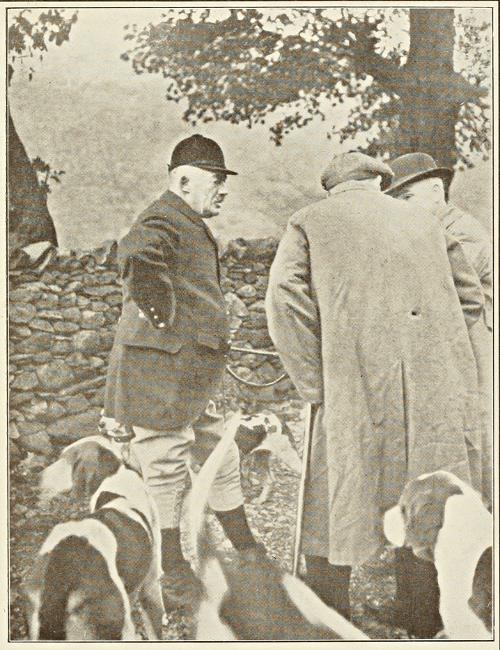
ULLSWATER FOXHOUNDS: OPENING MEET AT BROTHERSWATER, OCT. 11TH, 1919.
A faint note sounds, and then another, and gradually the music swells and grows louder. Hounds have struck a drag, and are making their way towards a frowning crag which juts out from[81] the rough breast beneath you. Your companion, a hill-shepherd, moves off a few paces in order to get a better view, then suddenly turns and points with his stick, exclaiming, “Sista, yonder he gars!” You look quickly towards the point indicated, and there you see him, a fine fell fox, his brush held stiff and straight behind him, moving along with the smooth gliding action peculiar to his kind. Once he halts and looks back, then he resumes his easy pace. Your companion runs a few yards down the breast, and you are treated to a sample of a dalesman’s view-halloa. Scream after scream rings out, echoing from the crags. The fox, still in view, and unhurried, stops at the sound, glances back, then mends his pace and disappears round the end of a jutting crag. Hounds come like mad to the halloa, scrambling up the steep ground at a wonderful pace. The leaders strike the line, and there is a burst of music as the remainder of the pack settle to it, and go racing through the breast. You watch them until hidden by a shoulder of the hill, then scan the fell head anxiously for their reappearance. They are almost out of hearing, but suddenly the cry is carried back to you clear and distinct, and you see them climbing out at the fell head, looking like white ants in the distance. One glimpse you get, and they are gone over the fell top, heading for the rough ground beyond.
Although you meditate following them, your better judgment prevails, for this dale has not been previously disturbed, and you know that a litter has been bred there. It is more than likely that the fox will return ere long, so you walk a short distance up the narrow trod leading to the tops, and sit down to listen. Scattered about the fell slopes are the little Herdwick sheep, tiny things in comparison with a Southdown, but famed for their quality as mutton. Overhead, wheeling in wide spirals, a buzzard is rising to a dizzy height, his shrill “whee-u, whee-u,” sounding clear and distinct. Over the fell head you hear the raucous cry of a raven, and catch sight of a black speck floating into the distance. A stoat, not yet in his winter coat of white, darts in and out amongst the rocks below you, and you watch his antics until a distant sound catches your ear. You listen intently, yes, there it is again, surely the cry of a hound, although still a long way off. They must be coming back, for the sounds are nearer now, and louder. You take the glasses from their case, and scan the fell head. Yes, there they come, running fast, and their fox cannot be very far in front at that pace. Quickly you scan the ground between, and at last you see him coming gamely along, but far from fresh. Below you is a well-known earth, which is no doubt his refuge, but to-day there[83] are figures standing about it, so his entrance will be barred.
You lose sight of him, then a view-halloa rings out, and a whip cracks sharply. He has swerved from the figures on the earth and hounds are gaining fast. Gradually they edge him lower and lower, until the last rock left behind, he is threading a narrow trod amongst the bracken. It is “all over bar the shouting,” as you dash down the long grass slope, clear the intervening wall, and drop panting into the allotment on the other side. A scramble through a stony beck, ending with a sharp run, brings you in sight of hounds, racing from scent to view. A sharp turn, a gleam of white fangs, and Stormer rolls him over, to be buried beneath a living avalanche of white, and black and tan. Who-hoop! Who-hoop!
Such is a day worth living for with a fell pack. A quick find, a fast hunt, a good place to see it from, and a kill in the open; what more could the heart of hunter desire? The man who does much fell hunting will get his share of such days, and when they come they amply repay him for any past disappointments.
The regular followers of the fell packs consist chiefly of shepherds, dalesmen and the like, comparatively few of the local “gentry” being sufficiently keen to take more than a passing interest in the sport. The fine air on the tops, and the[84] strenuous exercise, beat all your doctor’s medicine, but I am afraid in these modern days people believe more in the latter than the former. The working men in the dales are the keenest of hunters. No matter on what task they are engaged, when hounds come near, they down tools and join in the chase. They work hard, too, at unearthing a fox which has got to ground amongst the rocks, where crowbar and hammer are often required to loosen up the huge boulders.
On the fells the huntsman is the only man who wears a scarlet coat, and he is assisted by a whipper-in, who may perhaps wear hunting-cap and dark grey jacket, relieved by a touch of red on the collar and a scarlet waistcoat.
The huntsman is followed by three or four fell terriers in couples, and generally a hound or two as well. These last are usually young hounds, or older members of the pack which he is prepared to let go when occasion warrants. Usually the whipper-in will take the highest ground, leaving the huntsman to go below. He often takes more coupled hounds with him to the tops, to “louse” them at some convenient moment. The terriers form a most important item of the Hunt. Without them it would be impossible to locate and evict a fox after he had got to ground.
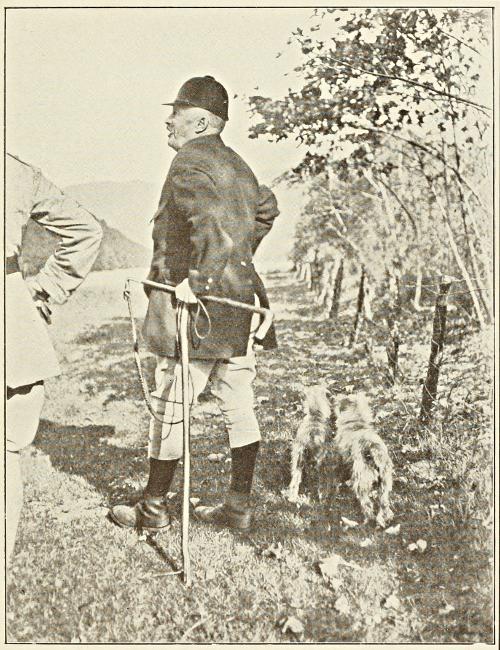
ULLSWATER FOXHOUNDS: JOE BOWMAN, HUNTSMAN (SINCE 1879).
Most of these terriers are cross-bred, showing more or less Bedlington blood, as evinced by the[85] light-coloured, silky hair on their heads. Silky body covering is not wanted on a fell terrier, for if the coat is too fine, the dog is unable to withstand wet and cold properly. These terriers vary considerably in size, but a very short-legged dog is handicapped on rough ground or in the snow. A biggish terrier is decidedly useful in places where he can work up to his fox, but in the majority of Lakeland borrans or earths, a smaller dog is to be preferred. A fox always takes good care to choose his defensive position underground, and a terrier has to attack him from below, and is thus at a disadvantage. Sometimes the positions are reversed, and the fox squeezes himself into a narrow crack, where he is unable to turn, thus exposing himself to a rear attack. As a rule, however, he is “head on” to his canine enemy, and then if he refuses to bolt, a battle royal ensues. A big dog-fox is no mean foe, and the combatants on both sides often get severely mauled. A sure sign that a fox is shifting his quarters underground is when the terriers cease marking, and the hounds begin to rush about the borran. It is surprising how a fox will bolt and escape his foes on such occasions. He creeps quietly to some convenient outlet, pauses an instant, then slips away, often unseen until he has placed some distance between himself and the hounds. Even after a mauling he will often beat hounds uphill on rough[86] ground, and end by getting to earth somewhere else.
Some of the Lakeland borrans are very deep places. It sometimes happens that although the terriers reach and possibly account for the fox, they are unable to return, and it may mean days of strenuous work ere the men can extricate them. At long intervals, more serious events occur, and despite all that can be done by willing hands, a rescue is impossible. Certain stone quarries and other places in Lakeland hold sinister reputations in this respect.
Some of the quarry “rubbish heaps” are composed of “big stuff” in the way of rocks, and are dangerous to open up, as the excavating process causes the upper material to unexpectedly rush in. In addition to shutting off the terriers, such a rush may easily bury or severely injure the men who are at work. I have seen one or two very narrow escapes of this kind, and they are decidedly unpleasant experiences.
It is, of course, usual for a man or two to mount guard at such borrans when hounds are advertised to meet in the neighbourhood, but even the keenest hunter becomes fed-up waiting perhaps for hours on a cold day, with only an occasional and distant sound of hounds to cheer his watch.
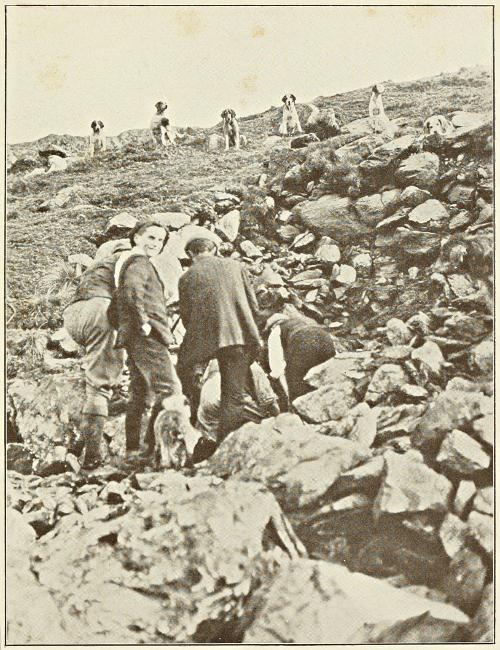
CONISTON FOXHOUNDS: “GONE TO GROUND.”
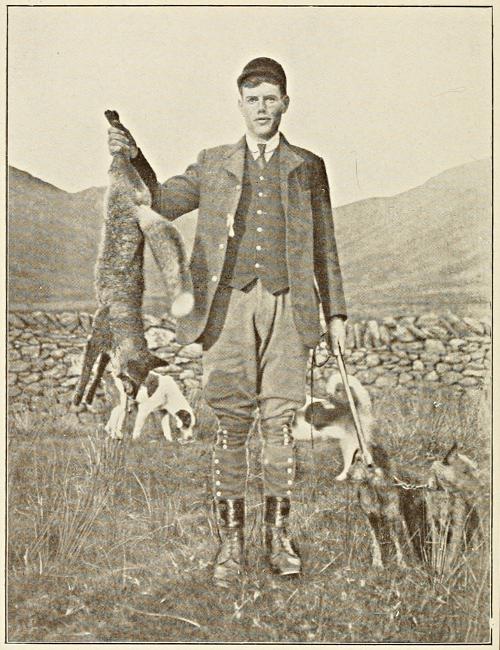
ULLSWATER FOXHOUNDS: B. WILSON, THE WHIPPER-IN.
Some foxes are almost impossible to keep out of such places. Despite halloing and whip-cracking[87] they will be in, no matter what you do. Others, again, sheer off at the slightest hint, and seek refuge elsewhere. Sometimes a fox has to get to ground where he can, and I have seen one get into what on the surface appeared to be quite a simple spot, defy all the best efforts of terriers and men to dislodge him.
As may be imagined, the huntsman to a fell pack must be a hard and tireless walker, for he has many miles of rough ground to cover from the time he leaves kennels in the morning until his return at dusk or later. Even he gets tired at times, but if it is humanly possible he will get all his hounds back to kennels before dark, or, at any rate, the same night.
Sometimes hounds have to be left out, but by the following day most of them will have found their way home again. On these occasions one or two of them may visit the farms or other places where they spend the summer, if anywhere near them; and after a feed or a sleep, resume their journey.
It is surprising how hungry one gets on the fells. I remember on one occasion following hounds from the Scandale valley, near Ambleside, over Fairfield, across Deepdale, and out again to the summit of Helvellyn. I was with the huntsman, and both of us had eaten our lunch some hours previously. On the summit of Helvellyn is a seat, and round it that afternoon were scattered[88] a lot of banana peelings. We were so hungry that we barely refrained from eating the latter. We have often laughed over it since, and I remember I made up for it with bread and cheese and beer when we got down off the mountain at dusk.
It is always advisable to take sufficient food with you on these occasions, for you are never quite certain when you are going to get the next meal.
Although some of the best sport is experienced in the cold weather, I have enjoyed some very good hunts in October, as well as spring. When foxes begin to bother the lambs, hounds are called upon to account for the offenders. It is, of course, necessary to meet very early at this time of year, as the sun soon dispels the dew, and scent is then often conspicuous by its absence. It well repays one for leaving one’s bed at an unearthly hour, however, when hounds do get away with their fox, for the temperature is such that one can sit about the tops in comfort, and thoroughly enjoy both the magnificent views and the sport. Many a May fox is rolled over by the fell packs, for the dalesmen’s flocks have to be made safe from any marauding vixen which takes toll of them for her cubs.
Harking back for a moment to fell terriers, people’s ideas appear to differ very considerably[89] as regards the make and shape of a dog used solely for sport.
A terrier for work on the fells must be able to squeeze through very narrow places, be active withal, and sufficiently high on the leg to enable him to follow the huntsman through snow or rough ground without tiring. Some people imagine that a terrier when creeping through a narrow place works himself along on his chest, and they conclude that a wide-chested, short-legged dog is the best for the purpose. As a matter of fact, the dog lies on his side, and works himself ahead with his legs. For this reason, an apparently big dog, that is, one fairly high on the leg, narrow, but deep through the heart, can get into some remarkably tight places. Terriers of the Sealyham type, short-legged, and broad-chested, whilst able to work in big badger earths, or wide drains, fail when it comes to negotiating narrow cracks and crevices in the rocks, such as foxes are so fond of taking refuge in, on the fells. It matters not how a terrier is bred, or what sort of a mongrel he is, so long as he is a worker, game and courageous to go up to his fox, bolt him, or make an end of him. “Handsome is as handsome does” is the motto on the fells, where nothing but real hard workers are tolerated for a moment.
Once a year there are certain shepherds’ meetings held in the Lake country, for the exchange[90] of sheep which have strayed. The two best known of these are held at the “Traveller’s Rest” inn on top of the Kirkstone Pass, and at the “Dun Bull” inn in Mardale.
On these occasions the foxhounds grace the meetings with their presence. The Coniston Foxhounds, and the Windermere Harriers attend the Kirkstone gathering, while the Ullswater provide sport at Mardale. This year (1919) the “Victory Meet” of the shepherds took place in Mardale on November 22nd. This gathering is one of the oldest of its kind in the country, and has been kept going for generations. How regular has been the attendance of some of the old-time dalesmen and shepherds may be gathered from the fact that a few years ago, one Thomas Fishwick put in his sixty-sixth annual appearance, and there are many others who have attended this meet for a score of years or more.
Special interest was attached to the “Victory Meet” in Mardale, as it was rumoured that it might be the last, owing to the acquisition of Haweswater by the Manchester Corporation. When the proposed scheme is completed, the famous “Dun Bull” and Mardale Church will be inundated.
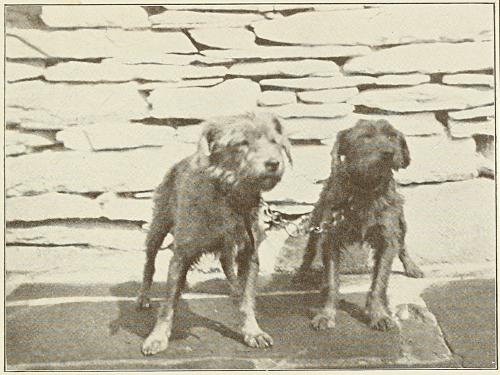
“PINCHER” AND “MYRTLE.” Two Coniston Hunt terriers.
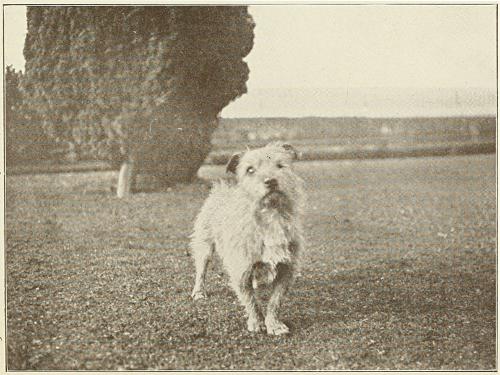
“JUMMY.” A terrier which did much good work for the Coniston Hunt.
In addition to a hunt, a hound-trail is held at Mardale. Some of the upholders of the fashionable hounds in the Shires, who believe that this[91] type is second to none for pace, would, I think, be inclined to change their opinion, if they timed one of these trails. The hounds entered are nothing more than fell foxhounds. Sometimes one of a litter bred at the kennels goes as a trail hound, and vice versâ. Yet, with all their pace, these hounds can hunt a cold line with the best, and will let you know all about it whilst they are doing it.
I have already mentioned the fact that the fell hounds pick up the drag of their fox, and work this out until they reach his hiding-place and unkennel him.
Sometimes the drag covers a long distance. When the Rev. E. M. Reynolds was Master of the Coniston Hounds, the latter picked up a drag near Rydal Park, carried it over High Pike up to Hart Crag, and down the ridge into Hartsop, where they unkennelled their fox in Low Wood overlooking Brothers’ Water. On another occasion the same pack struck a drag in Skelghyll Wood, near Windermere Lake, carried it forward the entire length of the Troutbeck valley, and out at Threshwaite Mouth at the fell head, unkennelling their fox about a mile beyond the last-mentioned point. As a rule, it is pretty safe to say that a drag which leads towards the high ground, is right, though on occasion such a line may prove to be heel-way. Even old and experienced hounds are not[92] infallible when it comes to differentiating between the right way and heel, despite the fact that one meets people who swear their hounds won’t run heel. After covering a lot of rough ground on the drag, and having at last unkennelled your fox, the real business of the day has only just begun. Before night, if you are in pursuit of an old stager, you may find yourself many miles from home, with darkness coming on, and a rough track to follow.
One of the longest, if not the longest, hunt I ever took part in occurred on January 15th, 1914. The Coniston Hounds met that day at Strawberry Bank, in the Winster valley. They found their fox at 10 o’clock, and the last followers of the field which started out in the morning, acknowledged themselves beaten at 5 p.m. Hounds ran for several hours longer, until darkness enabled the fox to finally shake off his pursuers. From the time hounds unkennelled their fox, until they were run out of scent, was 9½ hours, sufficient, I think, to constitute a record.
Such a day is one to be set down in red ink in the hunting diary.
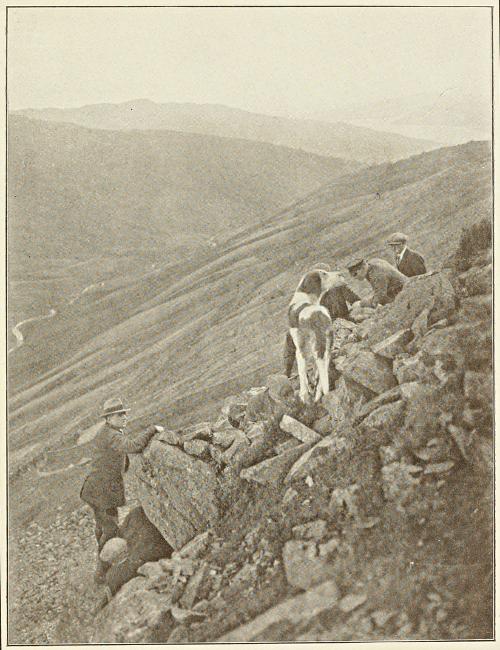
ULLSWATER FOXHOUNDS: GONE TO GROUND BELOW HIGH PIKE IN THE SCANDALE VALLEY.
Taking it all through, the fell country carries a good scent, except in early autumn and spring, when the sun exerts considerable power, and the bracken and dead leaves get very dry. There is little limestone in the district, but now and then[93] hounds run a fox to such places as Whitbarrow, where, unless the atmosphere is very damp, they often experience considerable difficulty in sticking to the line. “There’s nowt sae queer as scent,” and though we sometimes think we know a good deal about it, there generally comes a time when all our prophecies prove wrong. Now and then in the fell country there comes a day when the atmosphere is very clear, and there is an absence of wind. Overhead the clouds look heavy, and the day may be described as “dark.” The colour of the distant hills tones off from indigo to mauve; but for all the general effect of darkness, every stone and crag shows up distinctly. On such a day I have often known a screaming scent, while hounds could be both easily seen and heard.
Jorrocks, wise old bird, said, “Take not out your ’ounds upon a werry windy day,” and his advice is good, but for all that I have seen hounds run like mad in a gale, screaming along yards wide of the line, the scent drifting with the wind.
There are, of course, several factors that have an influence on scent. There is the fox himself, the nature of the soil (clay, gravel, etc.), the condition of the surface, such as grass, plough, moorland or woodland; the temporary state of the surface, wet, dry, dusty, etc.; and the state of the weather.
As far as the fox is concerned, there is little doubt that he and his relations vary considerably in the amount of scent they give off. Much depends too, upon the behaviour of a fox, as to whether hounds can make the best use of his line. A straight-running fox is easier to hunt than a twisting one, while the body-scent—i.e. scent retained by the atmosphere—allows hounds to run with their heads up, the scent being “breast high.” That scent is often far too high I have proved over and over again. Many a time I have been walking to a meet, and at some favourite crossing place for foxes on a road, or elsewhere, I have caught the scent of a fox quite strongly. Whenever scent has thus been retained high in the atmosphere, I have never seen hounds able to run fast, for it is over their heads, and they cannot reach it. In the case of foot-scent, such as is left on a cold drag, hounds have to get their noses right down to it, and work it out patiently. Foot-scent will lead hounds to the exact spot where a fox jumps a wall, or creeps through a hedge, whereas with body-scent they may run fast, but quite wide of the exact line of their fox, the distance varying with the amount of wind. On a real good scenting day the scent appears to remain “breast high,” whereas on a bad scenting day, it disappears quickly, or rises too high for hounds.
Whenever a hunted fox is coursed by a shepherd’s dog, hounds invariably have great difficulty in owning the line afterwards. It seems as if the sudden fright contracts the glands, or whatever it is that permits scent to exude from the fox, and the scent never again appears to regain its original strength.
Water often saves a hunted fox, for I have known many a one practically beaten, be completely lost after it had entered a stream. As the fox’s strength fails, scent becomes weaker to some extent, and it only needs a sudden fright, like the appearance of a cur dog, or an unexpected halloa, to cause it to fade altogether. For this reason one cannot keep too quiet when hounds are running almost in view of their beaten fox. An injudicious halloa at such a time gets their heads up, and it is ten to one that the fox makes good his escape. Hounds know very well when they are closing up to their fox, and they require no outside assistance to expedite matters.
If hounds get away on top of their fox on a good scenting day, his doom is very likely to be sealed, no matter how fast he runs. If, however, he kept up the same pace for the same length of time on a moderate or bad scenting day, he would outrun them, especially if he put in a few sharpish turns.
Luckily for hounds, a fox never goes far at[96] his best pace unless hard pressed, instead he places a convenient distance between himself and the pack, and accommodates his pace to theirs. If he ran his hardest on a bad scenting day he would be liable to run into other dangers ahead, for, for all he knows, there may be other hounds in front of him, so he travels as slowly as he dare, while keeping a good look out.
Very high wind is not, as a rule, conducive to scent, but I have seen hounds run fast in such wind, which, in addition to being strong, was exceedingly cold. In December of this year (1919) one of the fell packs ran a fox up-wind against an icy gale on the tops, when the wind was so strong that we who were following them had more than once to lie down or be blown over the edge of the fell.
Rain, wind, and sun are responsible for the state of the ground, and exert their influence on scent. Too much rain is bad for scent, as the land gets waterlogged. Roughly speaking, scent appears to lie best when the ground is in good riding condition. Wind and sun dry out the ground and harden it, and frost does likewise. Hounds will always run better when it is hard with drought or frost than when it is very wet and holding. Grass generally carries a better scent than plough, though the latter in some districts appears very favourable to it.
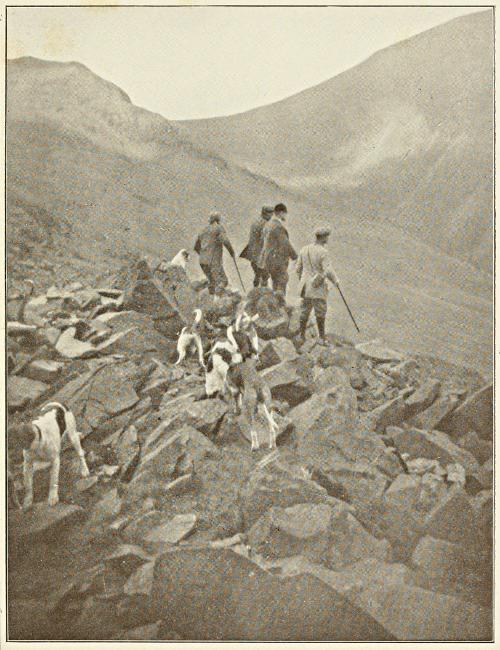
CONISTON FOXHOUNDS: WATCHING A HUNT FROM BROAD HOWE “BORRAN.”
The nature of the soil, being permanent, has much to do with scent. I am inclined to think that poor land carries a better scent than good land, while heather and moorland are more conducive to it than cold grass fields.
I know a district, all grass and moorland, in a limestone country, where scent lies very well indeed, except actually on the bare limestone. On the extensive outcrops of this kind of stone hounds are generally brought to their noses, unless the limestone is damp with rain.
A white frost is often bad for scent, and almost always so if the sun gets out at all warm. In the afternoon, should the ground harden again, hounds may be able to run quite well. I have noticed that towards evening, under varied conditions of weather, scent is often better than earlier in the day. Snow, if damp, and not too deep, often carries a good scent. In deep, soft snow, hounds can soon account for their fox if they get away close to him, as their greater length of leg gives them the advantage in such “going.”
When all is said and done, there appears to be no absolute rule to go by regarding scent. The “dark” day previously mentioned comes pretty near to it, however, and I always expect good scenting conditions on such a day.
Seeing that the true charm of all field sport is its “glorious uncertainty,” it is perhaps just as[98] well that we cannot pick and choose our hunting days, but must take the good with the bad, and be thankful for them.
After unkennelling a fox on a very windy day, I have heard people exclaim, “Oh! he’ll never face this wind on the top.” Despite such opinions the fox generally does face even the strongest wind, if he has made up his mind to reach some particular point.
It should be remembered that a fox stands a great deal lower than a man, and offers much less resistance to the wind.
I once remember sheltering on Wetherlam behind a boulder, my companion being the huntsman of the Coniston Hounds. It was a wild, windy day, in fact, the wind was so strong that when facing it we could scarcely breathe. There was snow on the ground at the time, and hounds were running on the breast far below us. We were just about to leave our shelter when we[100] espied a fox coming towards us. He was travelling right in the teeth of the gale, which did not appear to trouble him much. He never saw us till we ran in and loosed two couples of hounds at him, when he quickened his pace, and was soon out of sight.
I have, in a previous chapter, mentioned the fact of a fox lying on a ledge and refusing to move until a well-aimed stone dropped almost on top of him. That reminds me of another occasion when I was blackgame shooting on some rough ground on the fell. I fired at a blackcock which flew over me from above, missing him with the first barrel, but stopping him with the second. As I was reloading, I happened to glance downhill, and much to my surprise saw a fox curled up, apparently asleep, on top of a big flat rock. I threw a stone at him, which caused him to raise his head, and a second missile made him get off the rock, and take refuge underneath it. I waited a minute or two, but as he did not appear I rolled a big stone down the slope. It happened to land square on top of the fox’s shelter, and out he shot, jumping into a thick bracken bed, from the harbour of which he kept stopping to look back at me. It seemed strange that a fox should lie curled up on a rock, and allow me to make a noisy approach, in addition to firing the gun, without his showing the least sign of uneasiness.
On another occasion, near the same place, I was shooting with a companion. The snow was deep and the going very bad. I was well up the hill-side when I heard my companion exclaim, “Look out!” Expecting a hare, I got ready to shoot, when over a knoll appeared a fine big fox. I could have blown his head off, but instead I saluted him with a halloa, and away he went towards the high ground. Evidently he, too, found it bad travelling, as I saw him flounder and slip several times before he went out of sight.
As an example of the pace of a fell hound on rough ground, I will relate the following. The Coniston Hounds found a fox in a ghyll on Roughsides, overlooking the Kirkstone Pass. A very fast hound named Chanter, gained a long start with this fox, and crossed the Kirkstone road not far behind him. The fox made straight up the steep side of Dod End, when it suddenly dawned on us that the hound was fast gaining. In a very short time he overhauled his fox, and I expected to see the latter rolled over. Instead, the fox whirled round and “set” the hound, and there they stood, fangs bared, grinning at each other. I was watching the scene through field-glasses, and not till the remainder of the pack arrived on the scene did Reynard make a bolt for liberty. They turned him in very quickly, however, and rolled[102] him over close to the road. It is only fair to add that this fox was slightly mangy, which probably accounted for his not being able to get clear. I have his mask on the wall now, and never saw one armed with bigger fangs.
Railways are seldom a danger to the fell hounds, though occasionally the latter run foul of them. On March 9th, 1911, the Blencathra Hounds were running their fox between the metals of the Cockermouth, Keswick and Penrith Railway. Neither fox nor hounds noticed the approach of a passenger train on its way to West Cumberland. Luckily, however, the engine-driver managed to bring the train to a standstill, when the fox was only a few yards from the engine. A few minutes later hounds accounted for their fox close to Bassenthwaite Lake.
A rather amusing incident occurred on one occasion at Wythburn, near the head of Thirlmere Lake. Two of the Blencathra hounds got well away with their fox, and were not caught by the rest of the pack until after they had rolled him over in the fields bordering the Lake. A zealous youth, instead of leaving the fox for the pack to run up to, ran in, and thinking Reynard was dead, picked him up. He quickly dropped the supposedly defunct carcass, however, when two rows of remarkably sharp white teeth met in his hand.
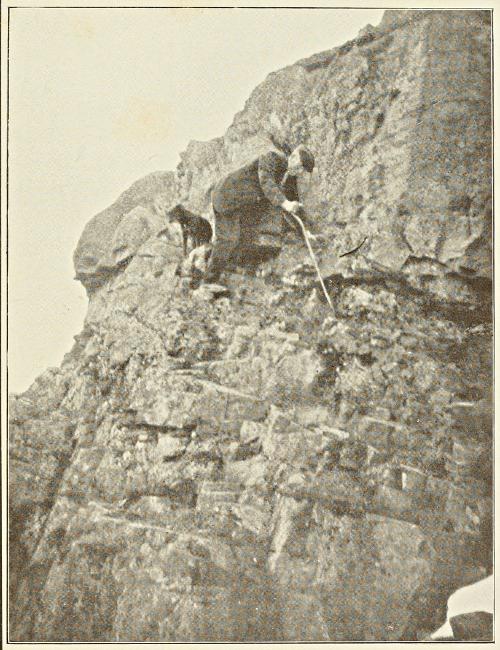
CONISTON FOXHOUNDS: ROUGH GOING NEAR DOVE CRAG.
Nothing stops a really keen fell hunter from enjoying the sport he loves best. I know at least two men with wooden legs who regularly follow hounds, and would shame many a sound person when it comes to travelling on the hills.
There is a story concerning two hunters who used to follow hounds above Dockray. I believe one of them was a relation of Joe Bowman, the well-known huntsman of the Ullswater. Anyway, this ancestor of Joe’s was deaf and dumb, while his friend and hunting partner was blind.
The latter’s stock saying to his mate, when hounds were out, was, “Thou mun lissen, an’ I’ll leak (look).”
That big foxes are not altogether confined to the fell country is attested to in Frank Gillard’s “Reminiscences.” Gillard mentions a big, mangy dog-fox which the Belvoir Hounds killed at Aswarby. Had this fox been in good condition he would have weighed over eighteen pounds; as it was he turned the scale at seventeen and a half pounds.
Apropos of the famous “Dun Bull” inn, in Mardale, mentioned in a previous chapter in connection with the shepherds’ “Victory Meet,” is the following yarn.
The Ullswater had a good hunt in Longsleddale, eventually running their fox to ground in Mardale.[104] A terrier was put in, and the fox bolted, affording another scurry before he was killed.
At the finish of the hunt a youth approached Mr. Farrer, of Howtown, the owner of the terrier, “Lucky Jim,” which had bolted the fox; and the following conversation ensued:
Youth: “Did your Jim worry the fox?”
Mr. F.: “No, my lad, he bolted.”
Youth: “Ay, an’ thou’ll bolt summat when thoo gits to t’ Dunny (Dun Bull).”
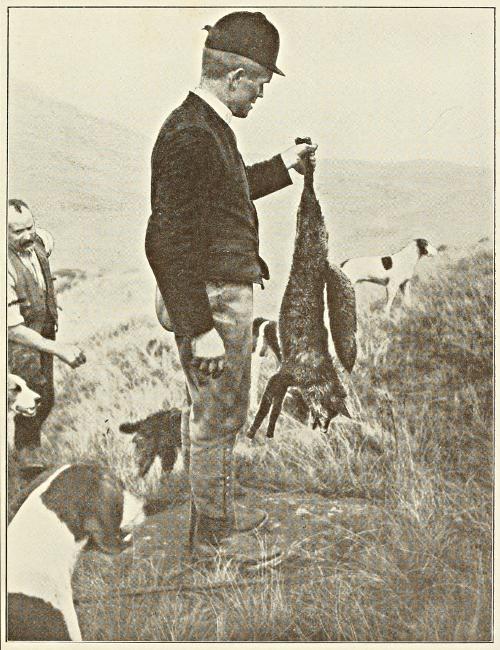
CONISTON FOXHOUNDS: GEORGE CHAPMAN, THE HUNTSMAN, WITH FOX, AFTER A KILL IN GREENBURN.
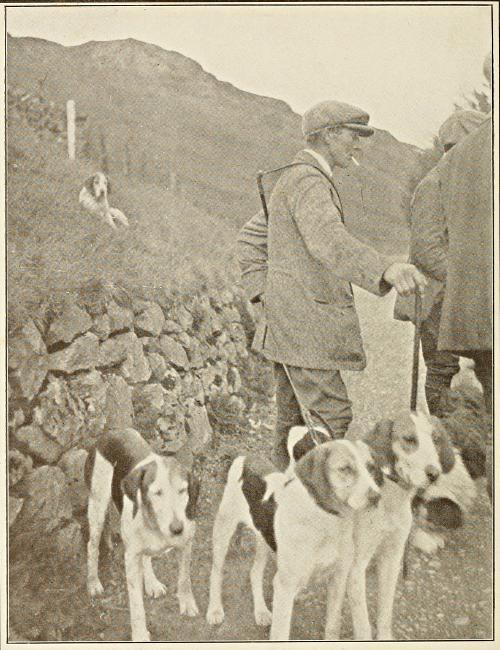
BLENCATHRA FOXHOUNDS: ERNEST PARKER, THE WHIPPER-IN.
That a promising day may finish in gloom, the following experience will prove. In the last week of October, 1910, the Coniston Hounds found a fox at Pinch Crags, in Scandale. After a short but fast hunt, they rolled him over in the open. The day being still young, hounds were taken to High Pike, where a second fox was soon unkennelled. After a fast hunt this fox took refuge on the face of Dove Crag, dropping from ledge to ledge, with three hounds, Crafty, Rally and Ringwood in pursuit. Eventually the fox, in attempting to cross an impassable ghyll, owing to pressure from the young hound, Crafty, slipped and fell several hundred feet, and met its death on the rocks far below. Unfortunately, the hound shared the same fate, whilst Rally and Ringwood became hopelessly crag-fast on one of the numerous ledges. A rope and willing assistants were brought from the quarry on Red Screes, and eventually the[105] hounds were rescued from their precarious position. It was an exciting adventure, and one which, thank goodness, does not often happen.
It was a coincidence that another fell pack, the Eskdale and Ennerdale, should have got some of their hounds crag-fast on Scawfell during the same week. Charmer, one of the best hounds in the pack, was found lying dead at the foot of the crags, and another hound, Melody, was badly injured. Ropes were secured at Wastdale Head, and J. Gaspard, a French guide, with two others, roped themselves together, and went 180 feet down the crag face. They rescued the remaining hounds, despite a continuous downpour of rain and severe cold.
Occasionally a fox ends his life in one of the many lakes scattered about the fell country. On New Year’s day, 1912, the Mellbrake Hounds got on to a fox which had stolen away near Foulsyke. They had a screaming hunt, towards the end of which hounds raced through the shrubbery at Loweswater Hall, and forward across the Lamplugh road to the lake. At the edge of the water one of the hounds “clicked” the fox, but could not hold him, Reynard plunged in, but sank when a few yards out from shore.
On one occasion the Blencathra Hounds ran a fox from Wanthwaite Crag to Grasmere village, where he “benked” on the window-sill of a[106] cottage. A woman rushed out of the latter, armed with a broom, and forbade either huntsman or hounds to enter the garden, which was well fenced in. Eventually, however, she was persuaded, and after fair law had been allowed the fox, the hunt continued.
At another time a certain pack ran a fox into a crag where it “benked” in rather a difficult place. Hounds could not get to it, so a man was lowered in on a rope. He succeeded in shifting Reynard “out of that,” and away went hounds in hot pursuit. Oblivious to all else but the hunt, the men on the top utterly forgot their mate dangling in mid-air below them, and not until his frantic yells reached their ears did they set about the business of hauling him up.
It is not often one has the chance of seeing the finish of a hunt from a motor-car, but on one occasion I remember doing so. Hounds were running hard on Gummershow, overlooking the lower end of Windermere Lake. I was heading towards the lake when a friend’s car overtook me. Jumping in, we careered down a side-lane, and turned sharp into the main road, just as hounds forced their fox across it, and killed him near the lake shore.
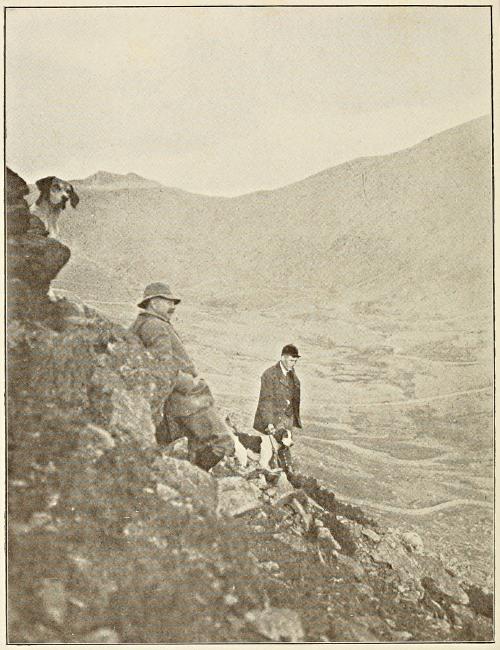
ULLSWATER FOXHOUNDS: OPENING MEET, OCT. 11TH, 1919.
On one occasion the Windermere Harriers brought a fox to hand at Blakerigg at the head of the Easedale valley. Anthony Chapman, now[107] landlord of the famous “Mortal Man” hotel in Troutbeck, was huntsman at the time, and that day the only follower was one Isaac Thompson. The carcass of the fox was laid upon a flat rock when Anthony turned to his friend and exclaimed, “Why, Isaac, we’ve never halloed!”
To kill a fox without a death halloa was a sad omission, so a combined who-whoop rent the air, and awoke the echoes amongst the crags. In fact, it did more than that, it brought the supposedly dead fox to life, and sent him helter-skelter down the rough fell breast in a final dash for liberty. Hounds viewed him and flew in hot pursuit, and after a smart burst, rolled him over in the bottom near the tarn. To this day Anthony delights to tell the tale of the fox which was “killed twice over.”
On another occasion the same pack had a good run, which ended with a check near a gateway in a lane. After casting round with no result, a boy suddenly appeared on the scene, and exclaimed:
“What are you laiting?” (looking for).
“I’se laiting a fox!” replied Anthony.
“What, So-and-so (giving the name) has it tied up i’ t’ barn,” said the youth.
On making investigation, sure enough there was the fox tied up with a collar and chain in one of the farm buildings.
The party responsible for the deed was a local[108] of the “not quite sharp” persuasion, who had arrived at the gateway just as hounds ran into their fox; and had rescued the latter little or nothing the worse.
Anthony, determined to let hounds have their reward, bought the fox from its captor, and after giving it due law, the pack was laid on. Having received his money, the “not quite sharp” gentleman mounted a near-by wall and commenced to stone the huntsman for all he was worth. Anthony, to escape this fusillade, hurriedly departed in the wake of his hounds, the latter rolling their fox over in the open, after a sharp scurry.
The “twice killed fox” yarn reminds me of another incident that happened some years ago.
Hounds ran their fox to ground, and after a pitched battle with the terriers, Reynard’s carcass was secured and withdrawn. The body was placed on a rock out of reach of the pack, whilst the field held a heated discussion as to which of the nearest inns should be honoured with their presence for the “harvel,” or celebration.
After some haggling, the momentous question was settled, and a move was made, when it was discovered that the fox had disappeared. Reynard had revived sufficiently to get up and slink away, and though hounds were laid on, they never caught him, for he got to ground in a place where it was utterly impossible to reach him.
In November, 1919, the Blencathra Hounds, after a good hunt above St. John’s-in-the-Vale, put their fox to ground in a narrow fissure of rock near the summit of Wanthwaite. A terrier was put in, and after a pitched battle, the dog accounted for the fox, but refused to leave the carcass. Darkness was coming on, so huntsman and field had reluctantly to leave the spot in order to make the difficult descent to the dale. Next morning the huntsman and whipper-in returned to the place, and found the carcass of the fox, with the terrier lying dead beside it, outside the “borran.” The fox had inflicted severe, if not fatal, injuries on the game little dog, and the latter, having dragged the body of his foe from underground, had still refused to leave it, and had so perished from exposure during a bitterly cold night.
I was out one day when the Coniston Hounds ran a fox to ground near Dod Bields, in Caiston. A terrier was put in, and after a stiff fight, the fox was accounted for underground. Several hours’ hard work failed to secure the carcass, so as daylight had given place to moonlight, we made our way across the summit of Red Screes, and so down to the “Traveller’s Rest” at the head of the Kirkstone Pass. Next day several willing hunters returned to the place, and after much labour, unearthed not one dead fox, but two. Both foxes were jammed up close to the end of a narrow[110] tunnel, and it was supposed that the one in the rear had been smothered to death.
On another occasion in the Troutbeck valley, hounds ran a fox to ground in a drain. A terrier was put in, and the fox bolted, giving hounds a very fast spin straight downhill. They practically never broke view, and rolled him over directly. Whilst the field were occupied in watching them, a second fox, which proved to be the hunted one, made his appearance from the drain, and going off rather stiffly, got to ground in a quarry “rubbish heap,” from which it was impossible to dislodge him.
Foxes will often lie extraordinarily close in long heather. I was out one day with the Ullswater, and we tried a lot of country without a sign of a drag or a line of any sort. Eventually we tried a heather-covered allotment between Kentmere and Troutbeck. Still there was no sign of a fox, and the field was beginning to get rather discouraged, when suddenly, right in the middle of hounds, a fox sprang out of the heather. How he ever escaped is a mystery, but get clear he did, giving a straight away hunt by way of Rainsbarrow and the head of the Kentmere valley, where hounds “laid him in,” and finally rolled him over at the edge of Kentmere reservoir, after a screaming thirty minutes’ hunt, without the semblance of a check from start to finish.
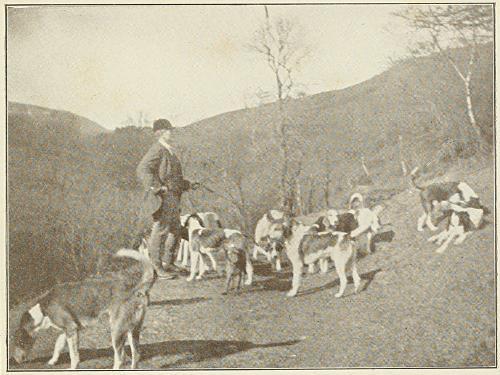
CONISTON FOXHOUNDS: HOUNDS AND THEIR HUNTSMAN IN THE SCANDALE VALLEY.
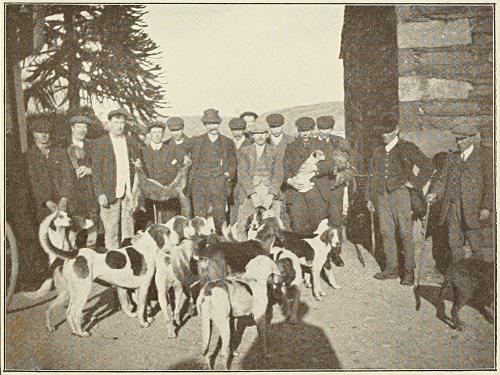
CONISTON FOXHOUNDS: AFTER A KILL NEAR CONISTON.
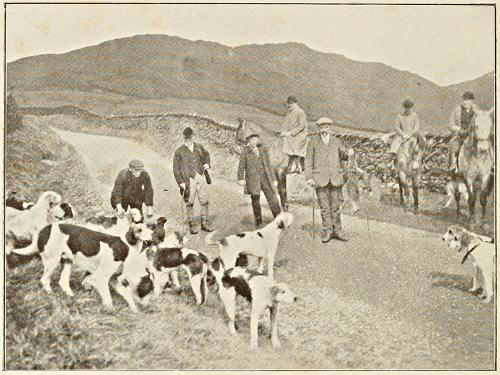
CONISTON FOXHOUNDS: AFTER A KILL IN WOUNDALE.
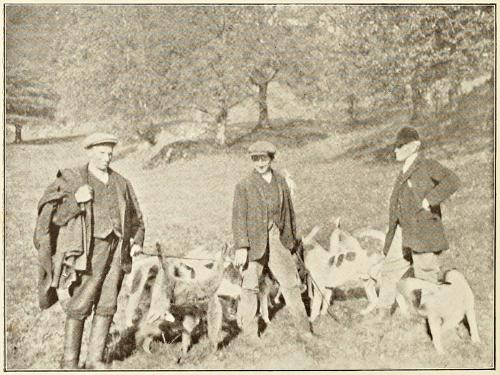
CONISTON FOXHOUNDS: AFTER A KILL ON NAB SCAR, RYDAL.
In a previous chapter I have mentioned the fact that occasionally some fell hound hunts, and finally kills or runs his fox to ground “on his own.” I remember the Ullswater Hounds threw off on one occasion at the quarry above Troutbeck Park, on the steep side of Ill Bell. Hounds struck a line which took them over the summit of the fell into the Kentmere valley. I was talking to Joe Bowman the huntsman, when we heard a single hound running very fast in our direction. It proved to be one of the lady members of the pack, a very fast bitch, and she was driving her fox at a tremendous pace. In a short time she ran him to ground on the Tongue, where Reynard crept in beneath a huge boulder on the fell side. A terrier was put in, and immediately got to the fox, but without tools it was impossible to reach them. Some quarrymen eventually came across with the necessary articles, including a fuse, and a charge of powder. It was found necessary to crack the boulder with the powder, after which the broken rock was removed, and terrier and fox were drawn out, fast locked together, from a very narrow and wet earth-hole. It was almost impossible to distinguish between them, so plastered were they with wet mud. The terrier was pried loose and the fox thrown down, when rather to our surprise he got on to his legs and made a bid for liberty. His race was soon run, however, as[112] the bitch and some young hounds the huntsman had with him, soon rolled him over. The terrier which had been nearly smothered in the earth, died the day after, despite all that could be done for it.
In December, 1919, the Coniston Hounds had a very fast hunt from a covert above Staveley village. Hounds finally drove their fox to the head of the Longsleddale valley, where it “benked” on a ledge on Goatscar. It had been a late find, and when the huntsman arrived on the scene, darkness was fast drawing in. The fox was at last made to vacate his dangerous resting-place, and he scrambled down a precipitous chimney on the face of the towering crag. Then ensued a wild and exciting scene, such as can only be experienced on the fells. The chimney was a dangerous place for hounds, with a fox dodging his way through them. Twice they had hold of him, but he wrenched free, and got clear at the chimney’s foot, where he soon outdistanced them across the rough scree-bed. One of the hounds fell a matter of fifty feet, but beyond being temporarily shaken appeared little the worse, and quickly resumed the chase. Snow was lying thickly on the tops, and it was just sufficiently light to see the fox climbing out for the summit of the crag again, where he ran through the roughest of the ground near the fell head, and finally disappeared on the wide top of[113] Harter Fell. Hounds followed him, and we saw them no more that night.
Many such incidents occur during the course of a season on the fells, and it is surprising that so few accidents happen, considering the dangerous nature of the country.
THE END
PRINTED IN GREAT BRITAIN BY
WILLIAM CLOWES AND SONS, LIMITED,
BECCLES.
End of the Project Gutenberg EBook of Foxhunting on the Lakeland Fells, by
Richard Clapham
*** END OF THIS PROJECT GUTENBERG EBOOK FOXHUNTING ON THE LAKELAND FELLS ***
***** This file should be named 57007-h.htm or 57007-h.zip *****
This and all associated files of various formats will be found in:
http://www.gutenberg.org/5/7/0/0/57007/
Produced by MFR and the Online Distributed Proofreading
Team at http://www.pgdp.net (This file was produced from
images generously made available by The Internet Archive)
Updated editions will replace the previous one--the old editions will
be renamed.
Creating the works from print editions not protected by U.S. copyright
law means that no one owns a United States copyright in these works,
so the Foundation (and you!) can copy and distribute it in the United
States without permission and without paying copyright
royalties. Special rules, set forth in the General Terms of Use part
of this license, apply to copying and distributing Project
Gutenberg-tm electronic works to protect the PROJECT GUTENBERG-tm
concept and trademark. Project Gutenberg is a registered trademark,
and may not be used if you charge for the eBooks, unless you receive
specific permission. If you do not charge anything for copies of this
eBook, complying with the rules is very easy. You may use this eBook
for nearly any purpose such as creation of derivative works, reports,
performances and research. They may be modified and printed and given
away--you may do practically ANYTHING in the United States with eBooks
not protected by U.S. copyright law. Redistribution is subject to the
trademark license, especially commercial redistribution.
START: FULL LICENSE
THE FULL PROJECT GUTENBERG LICENSE
PLEASE READ THIS BEFORE YOU DISTRIBUTE OR USE THIS WORK
To protect the Project Gutenberg-tm mission of promoting the free
distribution of electronic works, by using or distributing this work
(or any other work associated in any way with the phrase "Project
Gutenberg"), you agree to comply with all the terms of the Full
Project Gutenberg-tm License available with this file or online at
www.gutenberg.org/license.
Section 1. General Terms of Use and Redistributing Project
Gutenberg-tm electronic works
1.A. By reading or using any part of this Project Gutenberg-tm
electronic work, you indicate that you have read, understand, agree to
and accept all the terms of this license and intellectual property
(trademark/copyright) agreement. If you do not agree to abide by all
the terms of this agreement, you must cease using and return or
destroy all copies of Project Gutenberg-tm electronic works in your
possession. If you paid a fee for obtaining a copy of or access to a
Project Gutenberg-tm electronic work and you do not agree to be bound
by the terms of this agreement, you may obtain a refund from the
person or entity to whom you paid the fee as set forth in paragraph
1.E.8.
1.B. "Project Gutenberg" is a registered trademark. It may only be
used on or associated in any way with an electronic work by people who
agree to be bound by the terms of this agreement. There are a few
things that you can do with most Project Gutenberg-tm electronic works
even without complying with the full terms of this agreement. See
paragraph 1.C below. There are a lot of things you can do with Project
Gutenberg-tm electronic works if you follow the terms of this
agreement and help preserve free future access to Project Gutenberg-tm
electronic works. See paragraph 1.E below.
1.C. The Project Gutenberg Literary Archive Foundation ("the
Foundation" or PGLAF), owns a compilation copyright in the collection
of Project Gutenberg-tm electronic works. Nearly all the individual
works in the collection are in the public domain in the United
States. If an individual work is unprotected by copyright law in the
United States and you are located in the United States, we do not
claim a right to prevent you from copying, distributing, performing,
displaying or creating derivative works based on the work as long as
all references to Project Gutenberg are removed. Of course, we hope
that you will support the Project Gutenberg-tm mission of promoting
free access to electronic works by freely sharing Project Gutenberg-tm
works in compliance with the terms of this agreement for keeping the
Project Gutenberg-tm name associated with the work. You can easily
comply with the terms of this agreement by keeping this work in the
same format with its attached full Project Gutenberg-tm License when
you share it without charge with others.
1.D. The copyright laws of the place where you are located also govern
what you can do with this work. Copyright laws in most countries are
in a constant state of change. If you are outside the United States,
check the laws of your country in addition to the terms of this
agreement before downloading, copying, displaying, performing,
distributing or creating derivative works based on this work or any
other Project Gutenberg-tm work. The Foundation makes no
representations concerning the copyright status of any work in any
country outside the United States.
1.E. Unless you have removed all references to Project Gutenberg:
1.E.1. The following sentence, with active links to, or other
immediate access to, the full Project Gutenberg-tm License must appear
prominently whenever any copy of a Project Gutenberg-tm work (any work
on which the phrase "Project Gutenberg" appears, or with which the
phrase "Project Gutenberg" is associated) is accessed, displayed,
performed, viewed, copied or distributed:
This eBook is for the use of anyone anywhere in the United States and
most other parts of the world at no cost and with almost no
restrictions whatsoever. You may copy it, give it away or re-use it
under the terms of the Project Gutenberg License included with this
eBook or online at www.gutenberg.org. If you are not located in the
United States, you'll have to check the laws of the country where you
are located before using this ebook.
1.E.2. If an individual Project Gutenberg-tm electronic work is
derived from texts not protected by U.S. copyright law (does not
contain a notice indicating that it is posted with permission of the
copyright holder), the work can be copied and distributed to anyone in
the United States without paying any fees or charges. If you are
redistributing or providing access to a work with the phrase "Project
Gutenberg" associated with or appearing on the work, you must comply
either with the requirements of paragraphs 1.E.1 through 1.E.7 or
obtain permission for the use of the work and the Project Gutenberg-tm
trademark as set forth in paragraphs 1.E.8 or 1.E.9.
1.E.3. If an individual Project Gutenberg-tm electronic work is posted
with the permission of the copyright holder, your use and distribution
must comply with both paragraphs 1.E.1 through 1.E.7 and any
additional terms imposed by the copyright holder. Additional terms
will be linked to the Project Gutenberg-tm License for all works
posted with the permission of the copyright holder found at the
beginning of this work.
1.E.4. Do not unlink or detach or remove the full Project Gutenberg-tm
License terms from this work, or any files containing a part of this
work or any other work associated with Project Gutenberg-tm.
1.E.5. Do not copy, display, perform, distribute or redistribute this
electronic work, or any part of this electronic work, without
prominently displaying the sentence set forth in paragraph 1.E.1 with
active links or immediate access to the full terms of the Project
Gutenberg-tm License.
1.E.6. You may convert to and distribute this work in any binary,
compressed, marked up, nonproprietary or proprietary form, including
any word processing or hypertext form. However, if you provide access
to or distribute copies of a Project Gutenberg-tm work in a format
other than "Plain Vanilla ASCII" or other format used in the official
version posted on the official Project Gutenberg-tm web site
(www.gutenberg.org), you must, at no additional cost, fee or expense
to the user, provide a copy, a means of exporting a copy, or a means
of obtaining a copy upon request, of the work in its original "Plain
Vanilla ASCII" or other form. Any alternate format must include the
full Project Gutenberg-tm License as specified in paragraph 1.E.1.
1.E.7. Do not charge a fee for access to, viewing, displaying,
performing, copying or distributing any Project Gutenberg-tm works
unless you comply with paragraph 1.E.8 or 1.E.9.
1.E.8. You may charge a reasonable fee for copies of or providing
access to or distributing Project Gutenberg-tm electronic works
provided that
* You pay a royalty fee of 20% of the gross profits you derive from
the use of Project Gutenberg-tm works calculated using the method
you already use to calculate your applicable taxes. The fee is owed
to the owner of the Project Gutenberg-tm trademark, but he has
agreed to donate royalties under this paragraph to the Project
Gutenberg Literary Archive Foundation. Royalty payments must be paid
within 60 days following each date on which you prepare (or are
legally required to prepare) your periodic tax returns. Royalty
payments should be clearly marked as such and sent to the Project
Gutenberg Literary Archive Foundation at the address specified in
Section 4, "Information about donations to the Project Gutenberg
Literary Archive Foundation."
* You provide a full refund of any money paid by a user who notifies
you in writing (or by e-mail) within 30 days of receipt that s/he
does not agree to the terms of the full Project Gutenberg-tm
License. You must require such a user to return or destroy all
copies of the works possessed in a physical medium and discontinue
all use of and all access to other copies of Project Gutenberg-tm
works.
* You provide, in accordance with paragraph 1.F.3, a full refund of
any money paid for a work or a replacement copy, if a defect in the
electronic work is discovered and reported to you within 90 days of
receipt of the work.
* You comply with all other terms of this agreement for free
distribution of Project Gutenberg-tm works.
1.E.9. If you wish to charge a fee or distribute a Project
Gutenberg-tm electronic work or group of works on different terms than
are set forth in this agreement, you must obtain permission in writing
from both the Project Gutenberg Literary Archive Foundation and The
Project Gutenberg Trademark LLC, the owner of the Project Gutenberg-tm
trademark. Contact the Foundation as set forth in Section 3 below.
1.F.
1.F.1. Project Gutenberg volunteers and employees expend considerable
effort to identify, do copyright research on, transcribe and proofread
works not protected by U.S. copyright law in creating the Project
Gutenberg-tm collection. Despite these efforts, Project Gutenberg-tm
electronic works, and the medium on which they may be stored, may
contain "Defects," such as, but not limited to, incomplete, inaccurate
or corrupt data, transcription errors, a copyright or other
intellectual property infringement, a defective or damaged disk or
other medium, a computer virus, or computer codes that damage or
cannot be read by your equipment.
1.F.2. LIMITED WARRANTY, DISCLAIMER OF DAMAGES - Except for the "Right
of Replacement or Refund" described in paragraph 1.F.3, the Project
Gutenberg Literary Archive Foundation, the owner of the Project
Gutenberg-tm trademark, and any other party distributing a Project
Gutenberg-tm electronic work under this agreement, disclaim all
liability to you for damages, costs and expenses, including legal
fees. YOU AGREE THAT YOU HAVE NO REMEDIES FOR NEGLIGENCE, STRICT
LIABILITY, BREACH OF WARRANTY OR BREACH OF CONTRACT EXCEPT THOSE
PROVIDED IN PARAGRAPH 1.F.3. YOU AGREE THAT THE FOUNDATION, THE
TRADEMARK OWNER, AND ANY DISTRIBUTOR UNDER THIS AGREEMENT WILL NOT BE
LIABLE TO YOU FOR ACTUAL, DIRECT, INDIRECT, CONSEQUENTIAL, PUNITIVE OR
INCIDENTAL DAMAGES EVEN IF YOU GIVE NOTICE OF THE POSSIBILITY OF SUCH
DAMAGE.
1.F.3. LIMITED RIGHT OF REPLACEMENT OR REFUND - If you discover a
defect in this electronic work within 90 days of receiving it, you can
receive a refund of the money (if any) you paid for it by sending a
written explanation to the person you received the work from. If you
received the work on a physical medium, you must return the medium
with your written explanation. The person or entity that provided you
with the defective work may elect to provide a replacement copy in
lieu of a refund. If you received the work electronically, the person
or entity providing it to you may choose to give you a second
opportunity to receive the work electronically in lieu of a refund. If
the second copy is also defective, you may demand a refund in writing
without further opportunities to fix the problem.
1.F.4. Except for the limited right of replacement or refund set forth
in paragraph 1.F.3, this work is provided to you 'AS-IS', WITH NO
OTHER WARRANTIES OF ANY KIND, EXPRESS OR IMPLIED, INCLUDING BUT NOT
LIMITED TO WARRANTIES OF MERCHANTABILITY OR FITNESS FOR ANY PURPOSE.
1.F.5. Some states do not allow disclaimers of certain implied
warranties or the exclusion or limitation of certain types of
damages. If any disclaimer or limitation set forth in this agreement
violates the law of the state applicable to this agreement, the
agreement shall be interpreted to make the maximum disclaimer or
limitation permitted by the applicable state law. The invalidity or
unenforceability of any provision of this agreement shall not void the
remaining provisions.
1.F.6. INDEMNITY - You agree to indemnify and hold the Foundation, the
trademark owner, any agent or employee of the Foundation, anyone
providing copies of Project Gutenberg-tm electronic works in
accordance with this agreement, and any volunteers associated with the
production, promotion and distribution of Project Gutenberg-tm
electronic works, harmless from all liability, costs and expenses,
including legal fees, that arise directly or indirectly from any of
the following which you do or cause to occur: (a) distribution of this
or any Project Gutenberg-tm work, (b) alteration, modification, or
additions or deletions to any Project Gutenberg-tm work, and (c) any
Defect you cause.
Section 2. Information about the Mission of Project Gutenberg-tm
Project Gutenberg-tm is synonymous with the free distribution of
electronic works in formats readable by the widest variety of
computers including obsolete, old, middle-aged and new computers. It
exists because of the efforts of hundreds of volunteers and donations
from people in all walks of life.
Volunteers and financial support to provide volunteers with the
assistance they need are critical to reaching Project Gutenberg-tm's
goals and ensuring that the Project Gutenberg-tm collection will
remain freely available for generations to come. In 2001, the Project
Gutenberg Literary Archive Foundation was created to provide a secure
and permanent future for Project Gutenberg-tm and future
generations. To learn more about the Project Gutenberg Literary
Archive Foundation and how your efforts and donations can help, see
Sections 3 and 4 and the Foundation information page at
www.gutenberg.org Section 3. Information about the Project Gutenberg
Literary Archive Foundation
The Project Gutenberg Literary Archive Foundation is a non profit
501(c)(3) educational corporation organized under the laws of the
state of Mississippi and granted tax exempt status by the Internal
Revenue Service. The Foundation's EIN or federal tax identification
number is 64-6221541. Contributions to the Project Gutenberg Literary
Archive Foundation are tax deductible to the full extent permitted by
U.S. federal laws and your state's laws.
The Foundation's principal office is in Fairbanks, Alaska, with the
mailing address: PO Box 750175, Fairbanks, AK 99775, but its
volunteers and employees are scattered throughout numerous
locations. Its business office is located at 809 North 1500 West, Salt
Lake City, UT 84116, (801) 596-1887. Email contact links and up to
date contact information can be found at the Foundation's web site and
official page at www.gutenberg.org/contact
For additional contact information:
Dr. Gregory B. Newby
Chief Executive and Director
gbnewby@pglaf.org
Section 4. Information about Donations to the Project Gutenberg
Literary Archive Foundation
Project Gutenberg-tm depends upon and cannot survive without wide
spread public support and donations to carry out its mission of
increasing the number of public domain and licensed works that can be
freely distributed in machine readable form accessible by the widest
array of equipment including outdated equipment. Many small donations
($1 to $5,000) are particularly important to maintaining tax exempt
status with the IRS.
The Foundation is committed to complying with the laws regulating
charities and charitable donations in all 50 states of the United
States. Compliance requirements are not uniform and it takes a
considerable effort, much paperwork and many fees to meet and keep up
with these requirements. We do not solicit donations in locations
where we have not received written confirmation of compliance. To SEND
DONATIONS or determine the status of compliance for any particular
state visit www.gutenberg.org/donate
While we cannot and do not solicit contributions from states where we
have not met the solicitation requirements, we know of no prohibition
against accepting unsolicited donations from donors in such states who
approach us with offers to donate.
International donations are gratefully accepted, but we cannot make
any statements concerning tax treatment of donations received from
outside the United States. U.S. laws alone swamp our small staff.
Please check the Project Gutenberg Web pages for current donation
methods and addresses. Donations are accepted in a number of other
ways including checks, online payments and credit card donations. To
donate, please visit: www.gutenberg.org/donate
Section 5. General Information About Project Gutenberg-tm electronic works.
Professor Michael S. Hart was the originator of the Project
Gutenberg-tm concept of a library of electronic works that could be
freely shared with anyone. For forty years, he produced and
distributed Project Gutenberg-tm eBooks with only a loose network of
volunteer support.
Project Gutenberg-tm eBooks are often created from several printed
editions, all of which are confirmed as not protected by copyright in
the U.S. unless a copyright notice is included. Thus, we do not
necessarily keep eBooks in compliance with any particular paper
edition.
Most people start at our Web site which has the main PG search
facility: www.gutenberg.org
This Web site includes information about Project Gutenberg-tm,
including how to make donations to the Project Gutenberg Literary
Archive Foundation, how to help produce our new eBooks, and how to
subscribe to our email newsletter to hear about new eBooks.